World, History of the. People have probably lived on Earth about 2 million years. In the earliest days, human groups established small societies throughout much of the world. People started to use writing about 5,500 years ago. The period before people began to write is usually called prehistory.
Archaeologists have pieced together the story of prehistory by studying things the people left behind. Such things include artwork, tools, ruins of buildings, fossils, and even their own skeletons. They provide the main evidence of what prehistoric people were like and how they lived. For a description of life in prehistoric times, see Prehistoric people.
The first traces of writing date from about 3500 B.C. From then on, people could record their own history. By writing down their experiences, they could tell future generations what they were like and how they lived. From these documents, we can learn firsthand about the rise and fall of civilizations and other important events. The history of the world—from the first civilizations to the present—is based largely on what has been written down by peoples through the ages.
The development of agriculture began around 9000 to 8500 B.C. It brought about a great change in human life. Prehistoric people who learned to farm no longer had to migrate in search of food. Instead, they could settle in one place. Some of their settlements grew to become the world’s first cities. People in the cities learned new skills and developed specialized occupations. Some became builders and craftworkers. Others became merchants and priests. Eventually, systems of writing were invented. These developments gave rise to the first civilizations.
For hundreds of years, the earliest civilizations had little contact with one another. For this reason, they developed independently. The progress each civilization made depended on the natural resources available to it and on the inventiveness of its people. As time passed, civilizations advanced and spread. The world’s population also rose steadily. The peoples of various civilizations began to exchange ideas and skills. Within each civilization, groups of people with distinctive customs and languages emerged. In time, some peoples, such as the Romans, gained power over others and built huge empires. Some of these empires flourished for centuries before collapsing. Great religions and later science and scholarship developed as people wondered about the meaning of human life and the mysteries of nature.
About 500 years ago, one civilization—that of western Europe—started to exert a powerful influence throughout the world. The Europeans began to make great advances in learning, the arts, science, and technology. The nations of Europe sent explorers and military forces to distant lands. They set up overseas colonies, first in the Americas and then on other continents, and conquered other regions. As a result, European customs, skills, political ideas, and religious beliefs spread across much of the world.
Today, the many peoples of the world continue to observe different cultural traditions. But they also have more in common than ever before. Worldwide systems of communications and transportation have broken down barriers of time and distance and rapidly increased the exchange of ideas and information between peoples. However far apart people may live from one another, they are affected more and more by the same political, economic, and cultural changes. In some way, almost everyone can now be affected by a war or a political crisis in a faraway land or by a rise in petroleum prices in distant oil-producing countries. The various cultures of the world are increasingly influencing one another. Much of world history is the story of the way different civilizations have come closer together.
Early centers of civilization
For hundreds of thousands of years, prehistoric people lived by hunting, fishing, and gathering wild plants. Even small groups of people had to migrate constantly over large areas of land to find enough food. A group usually stayed in one place only a few days or a few weeks. The discovery of agriculture gradually ended the nomadic way of life for many people. After prehistoric men and women learned to raise crops and domesticate animals, they no longer had to migrate in search of food. They could thus begin to settle in villages.
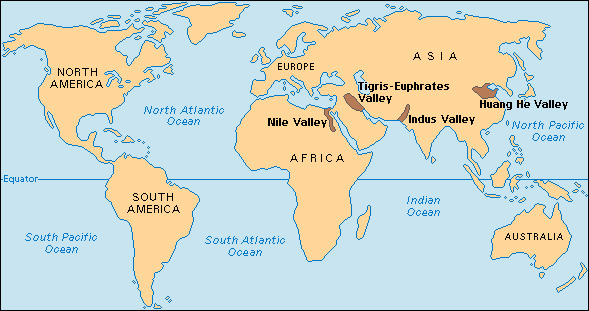
Agriculture was developed at different times in different regions of the world. The first domesticated crops probably emerged around 9000 to 8500 B.C. in an arc-shaped region of the Middle East called the Fertile Crescent. By around 8000 B.C., inhabitants of China and parts of Central and South America had also established early forms of agriculture. Other peoples either independently developed agricultural systems at later dates, or formed them as other agricultural centers migrated or spread.
The invention of farming paved the way for the development of civilization. As prehistoric people became better farmers, they began to produce enough food to support larger villages. In time, some farming villages developed into the first cities. The plentiful food supplies enabled more and more people to give up farming for other jobs. These people began to develop the arts, crafts, trades, and other activities of civilized life.
Agriculture also stimulated technological and social changes. Farmers invented the hoe, sickle, and other tools to make their work easier. The hair of domestic animals and fibers from such plants as cotton and flax were used to make the first textiles. People built ovens to bake the bread they made from cultivated grain. They learned to use hotter ovens to harden pottery. The practice of agriculture required many people to work together to prepare the fields for planting and to harvest the crops. New systems of government were developed to direct such group activities.
The changes brought about by agriculture took thousands of years to spread widely across Earth. By about 3500 B.C., civilization began. It started first in southwest Asia. Three other early civilizations developed in Africa and in south and east Asia. All these early civilizations arose in river valleys, where fertile soil and a readily available water supply made agriculture easier than elsewhere. The valleys were the Tigris-Euphrates Valley in southwest Asia, the Nile Valley in Egypt, the Indus Valley in what is now Pakistan, and the Huang He Valley in northern China.
While large, complex civilizations were developing in the river valleys, agriculture also appeared in other parts of the world. Most people in Europe, central and southern Africa, southeastern Asia, central Mexico, and the Andean region of South America began to cultivate their food after about 2000 B.C. They did not immediately build complex civilizations like those of the river valleys. However, they organized settled societies that later expanded and dominated large regions. See Agriculture (History).
The Tigris-Euphrates Valley.
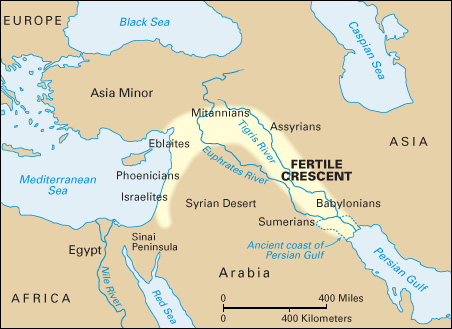
The Sumerians lived by farming, fishing, and hunting the wild fowl of the river marshes. They built dikes to control the flooding of the Tigris and Euphrates rivers and irrigation canals to carry water to their fields. By about 3500 B.C., some Sumerian farm villages had grown into small cities, which marked the beginning of the world’s first civilization. A number of these cities developed into powerful city-states by about 3200 B.C.
The Sumerians produced one of the greatest achievements in world history. By about 3300 B.C., they had invented the first form of writing. At first, this writing consisted of abstract and picturelike symbols scratched into clay. This system developed into cuneiform writing, which uses characters made up of small wedges (see Cuneiform). Archaeologists have found thousands of clay tablets with Sumerian writings. These tablets show the high level of development of the Sumerian culture. They include historical and legal documents; letters; economic records; literary and religious texts; and studies in mathematics, astronomy, and medicine.
The Sumerians used baked bricks to build great palaces and towering temples called ziggurats in their cities. They believed that their gods lived on the tops of the ziggurats. Sumerian craftworkers produced board games, beautifully designed jewelry, metalware, musical instruments, decorative pottery, and stone seals engraved with pictures and inscriptions. The Sumerians invented the potter’s wheel and were among the first people to brew beer and make glass. Their system of counting in units of 60 is the basis of the 360-degree circle and the 60-minute hour. See Sumer.
The Sumerian city-states had no central government or unified army. They continually struggled among themselves for power. As time passed, they were increasingly threatened by neighboring Semitic peoples, who were attracted by the growing wealth of the Tigris-Euphrates Valley. During the 2300’s B.C., a Semitic king, Sargon of Akkad, conquered Sumer. Sargon united all Mesopotamia under his rule, creating the world’s first empire. The Akkadians combined Sumerian civilization with their own culture. Their rule lasted more than 60 years. Then invaders from the northeast overran the empire. These invaders soon left Mesopotamia, and Sumer was once again divided into separate city-states. One city-state, Ur, briefly controlled all the others. See Sargon of Akkad.
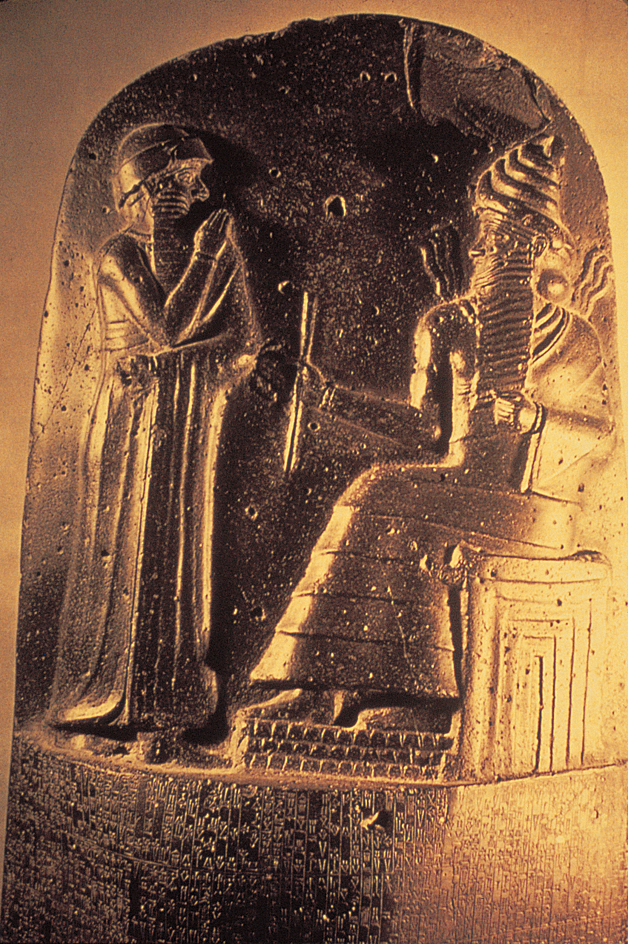
The Nile Valley.
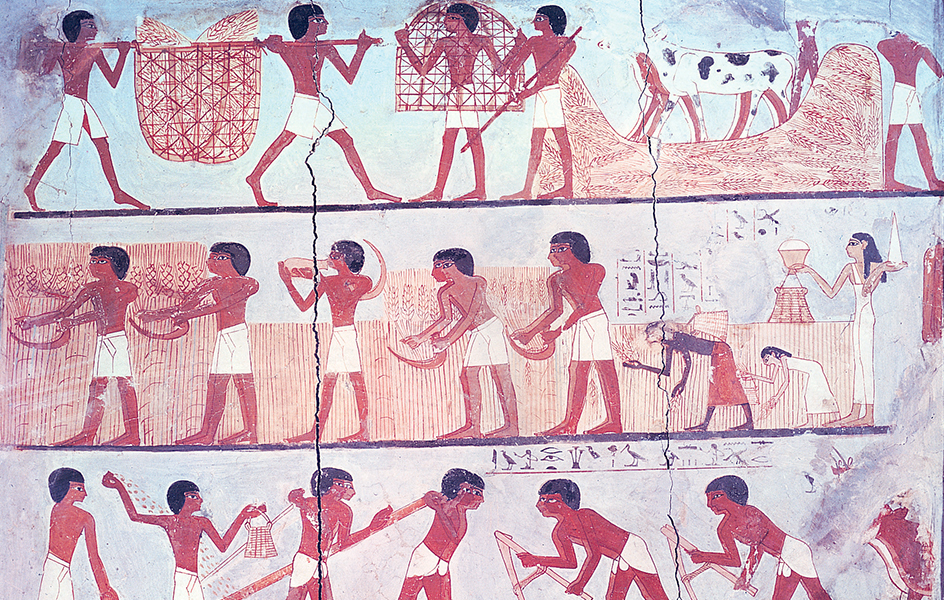
During the 3000’s B.C., Egypt consisted of two large kingdoms. Lower Egypt covered the Nile Delta. Upper Egypt lay south of the delta on the two banks of the river. About 3100 B.C., according to legend, King Menes of Upper Egypt conquered Lower Egypt and united the two kingdoms. Menes also founded the first Egyptian dynasty (series of rulers in the same family). The rulers of ancient Egypt were believed to be divine.
Loading the player...
Pyramids at Giza
The ancient Egyptians invented their own form of writing. It was an elaborate system of symbols known as hieroglyphics (see Hieroglyphics). They also invented papyrus, a paperlike material made from the stems of reeds. The Egyptians developed one of the first religions to emphasize life after death. They tried to make sure their dead enjoyed a good life in the next world. The Egyptians built great tombs and mummified (embalmed and dried) corpses to preserve them. They filled the tombs with clothing, food, furnishings, and jewelry for use in the next world. The most famous Egyptian tombs are gigantic pyramids in which the kings were buried. The pyramids display the outstanding engineering and surveying skills of the Egyptians. The government organized thousands of workers to construct the pyramids, as well as temples and palaces, in the Egyptian cities. The cities served chiefly as religious and governmental centers for the surrounding countryside. Most of the people lived in villages near the cities.
Over the years, huge armies of conquering Egyptians expanded the kingdom’s boundaries far beyond the Nile Valley. At its height in the 1400’s B.C., Egypt ruled Syria, Lebanon, Palestine, and part of the Sudan. As a powerful state at the junction of Asia and Africa, Egypt played an important role in the growth of long-distance trade. Egyptian caravans carried goods throughout the vast desert regions surrounding the kingdom. Egyptian ships sailed to all the major ports of the ancient world. From other lands, the Egyptians acquired gems, gold, ivory, leopard skins, fine woods, and other rich materials, which they used to create some of the most magnificent art of ancient times.
Although the ancient Egyptians had contacts with other cultures, their way of life changed little over thousands of years. Their civilization gradually declined. The Egyptians found it harder and harder to resist invaders who had greater vigor and better weapons.
Egyptian records from the 1200’s and 1100’s B.C. describe constant attacks by “sea peoples.” These peoples may have come from islands in the Aegean Sea or from lands along the east coast of the Mediterranean Sea. After 1000 B.C., power struggles between rival Egyptian dynasties further weakened the kingdom.
For a detailed description of life in ancient Egypt, see Egypt, Ancient.
The Indus Valley.
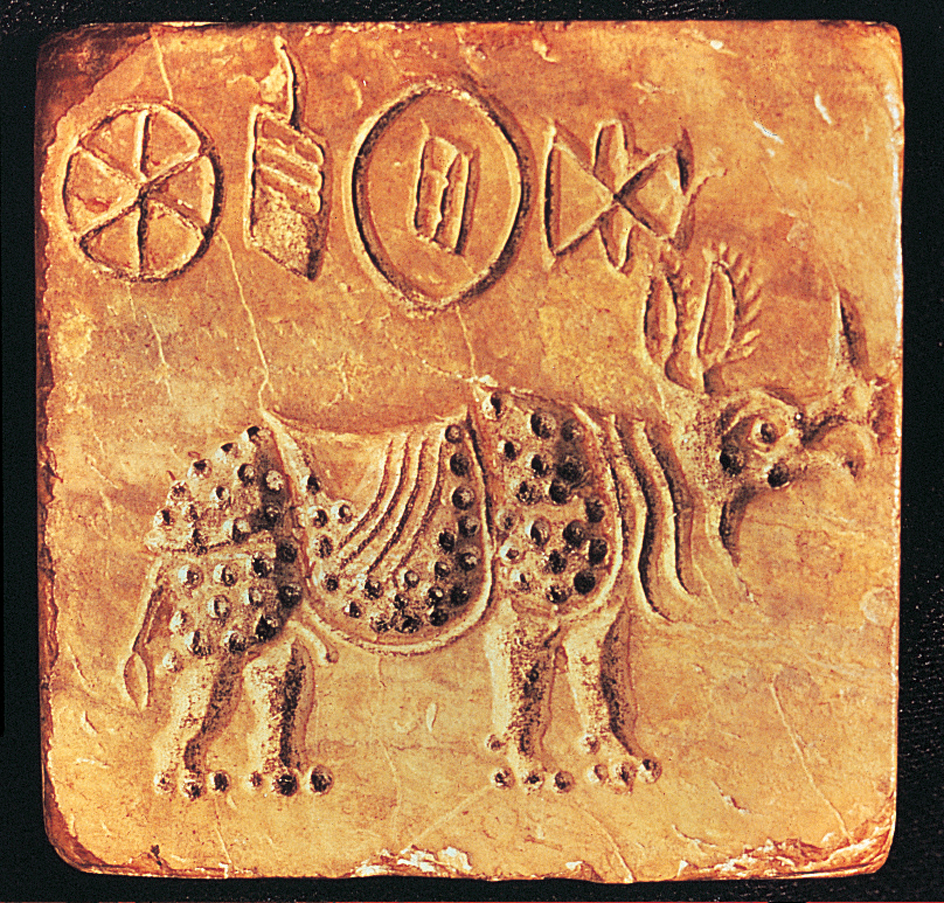
The growth of some small communities into larger cities, such as Mohenjo-Daro and Harappa, began by about 2600 B.C. The people of the Indus Valley had a well-developed system of agriculture that provided food for the large population. They dug ditches and canals to irrigate their farms. The Indus cities had brick buildings and well-planned streets laid out in rectangular patterns. Elaborate brick-lined drainage systems provided sanitation for the towns. Craftworkers made decorated furniture, fine jewelry, metal utensils, toys, and stone seals engraved with animal and human forms. Inscriptions on these seals, as well as on some pottery and a few other objects, provide the only traces of Indus writing known at present.
Archaeologists have discovered that standardized sizes of bricks and uniform weights and measures were used throughout the Indus Valley. The Indus settlements traded with one another and with foreign cultures. Traces of seals used on goods from the Indus Valley have been found as far away as Mesopotamia. The Indus people probably also traded with people of central Asia, southern India, and Persia.
Between 1900 and 1700 B.C., the Indus Valley civilization broke up into smaller cultures. Scholars do not know why this process of decay took place. Changing river patterns may have disrupted the agriculture and economy of the region. Overuse of the land along the riverbanks also may have caused environmental damage that led to decreased agricultural production throughout the Indus Valley. By about 1700 B.C., the Indus civilization had disappeared.
For more information on what archaeologists have discovered about the ancient Indus Valley culture, see Indus Valley civilization.
The Huang He Valley.
The earliest written records of Chinese history date from the Shang dynasty, which arose in the valley of the Huang He during the 1700’s B.C. The records consist largely of writings scratched on animal bones and turtle shells. The bones and shells, known as oracle bones, were used in religious ceremonies to answer questions about the future. After a question was written on an oracle bone, a small groove or hole was made in the bone. The bone was then heated so that cracks ran outward from the groove or hole. By studying the pattern of the cracks, a priest worked out the answer to the question.
Thousands of oracle bones have been found. They provide much information about the ancient Chinese. Many of the bones record astronomical events, such as eclipses of the sun and moon, and the names and dates of rulers. The system of writing used by the Shang people had more than 3,000 characters. Some characters on the oracle bones resemble those of the present-day Chinese language.
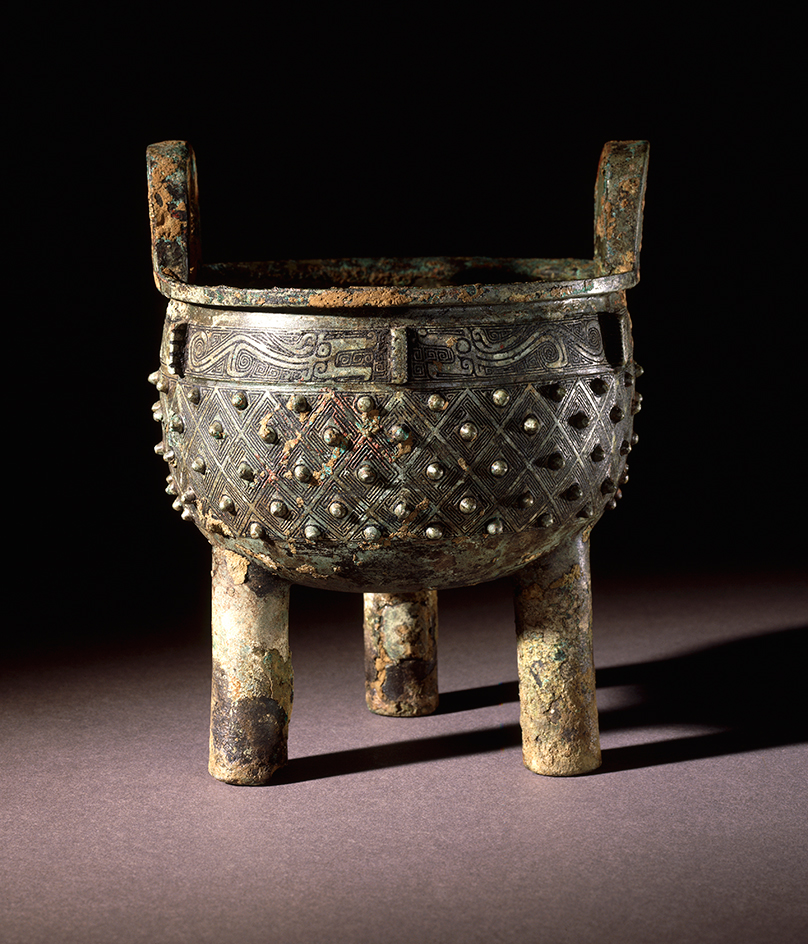
The Shang people were governed by a king and a hereditary class of aristocrats. The king and the nobility carried out religious as well as political duties. However, only the king could perform the most important religious ceremonies. The Shang leaders organized armies of as many as 5,000 men and equipped them with bronze weapons and horse-drawn war chariots. They used their armies to control the other peoples of the Huang He Valley. The Shang ruled much of the valley for about 600 years. For more information on the culture of the Shang, see Shang dynasty.
The advance of civilization
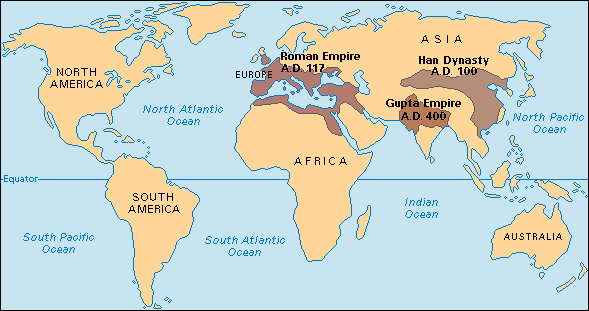
As the civilizations of ancient times grew and spread, they began to have certain features in common. By about A.D. 500, for example, all the major civilizations had learned how to make iron. The spread of such knowledge was helped by trade, conquest, and migration. Traders carried the products of one culture to other cultures. The soldiers of invading armies often settled in the conquered lands, where they introduced new ways of life. Groups of people migrated from one region to another, bringing the customs, ideas, and skills of their homelands with them.
The most important migrations in ancient times were made by peoples belonging to the Indo-European language groups. The Indo-European peoples once lived in the area north of the Black Sea, in southern Russia and the Ukraine. Sometime before 2000 B.C., large numbers of them began moving into Europe, into southwest Asia, and across the highlands of Persia to India. Many of the migrations resulted in the destruction of old states and the creation of new ones.
Civilizations of southwest Asia.
For several hundred years following 1200 B.C., various Indo-European and Semitic peoples struggled for power in southwest Asia. One of the Semitic peoples, the Hebrews, founded a kingdom in what is now Israel about 1029 B.C. The Hebrews, later called Jews, established the first religion based on the belief in one God. Their faith, called Judaism, had a lasting influence on human history. Both Christianity, the most widespread religion of modern times, and Islam, the religion of the Muslims, developed from Judaism. See Jews.
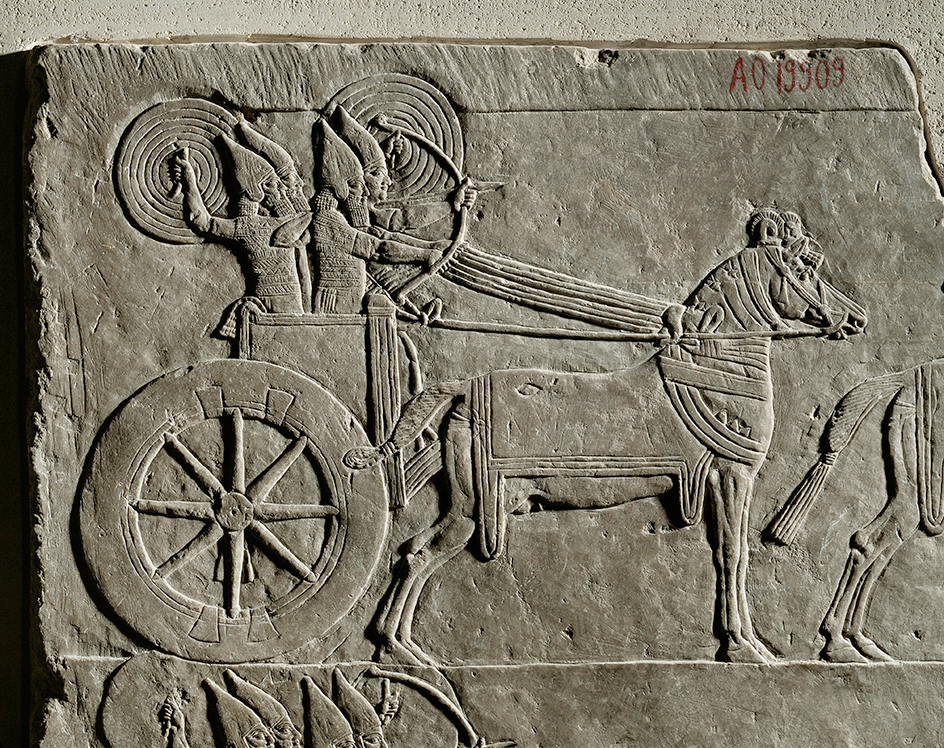
In 612 B.C., the Semitic Babylonians and an Indo-European people called the Medes joined forces and destroyed Nineveh. The Assyrian Empire thus ended. The Medes then established the Median Empire, which included the area north of Mesopotamia (see Media). In Mesopotamia and to the west, the Neo-Babylonian Empire, sometimes called the Chaldean Empire, came into being. Under its most famous ruler, Nebuchadnezzar II, Babylon became one of the most magnificent cities of the ancient world. Nebuchadnezzar probably built the Hanging Gardens, one of the Seven Wonders of the Ancient World (see Seven Wonders of the Ancient World).
About 550 B.C., the Persians, led by Cyrus the Great, overthrew the Medes and established the Persian Empire. Cyrus went on to conquer Babylonia, Palestine, Syria, and all Asia Minor. Cyrus’s son Cambyses added Egypt to the empire in 525 B.C. The Persians built excellent roads throughout their vast empire. They divided the empire into provinces. Each province was governed by a Persian official. Unlike the Assyrians, the Persians allowed the conquered peoples to keep their own religions and traditions. See Persia, Ancient.
The Persian Empire lasted more than 200 years. Under Persian rule, Medes, Babylonians, Jews, and Egyptians were united for the first time. Although they still had different traditions and customs, they could no longer be thought of as belonging to separate civilizations. Another people who came under Persian control were the Phoenicians, who lived along the coasts of what are now Syria, Lebanon, and Israel. The Phoenicians were great explorers and traders. They helped spread civilization among the peoples living in coastal areas along the Aegean Sea and in what is now Turkey. The Phoenicians developed an alphabet that became the basis of the Greek alphabet. All other Western alphabets, in turn, have been taken from the Greek. See Phoenicia.
The Greeks.
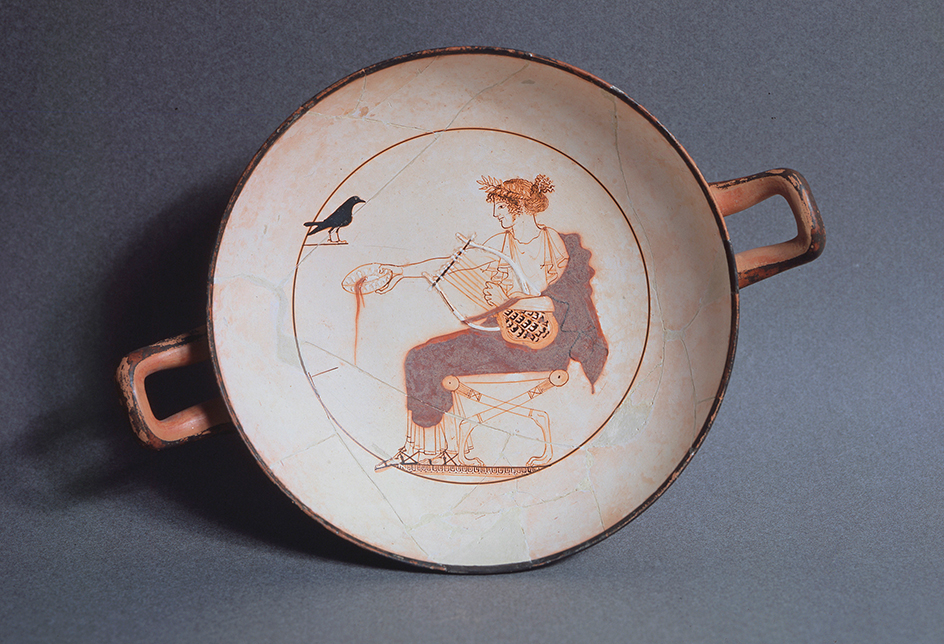
The Minoans traded with peoples in southwest Asia, Sicily, and Greece. Their trade routes provided an important link between the civilizations of southwest Asia and mainland Europe. Minoan culture flourished for about 500 years. It began to decline after 1450 B.C., when fire destroyed nearly all the towns on Crete. By about 1100 B.C., the culture had disappeared.
The most important early culture on the mainland of Greece centered on the southern city of Mycenae. The people of Mycenae were probably descendants of Indo-European peoples who had been migrating to Greece since about 2000 B.C. By the 1500’s B.C., the Mycenaean culture had become rich and powerful. Mycenae was the leading political and cultural center on the Greek mainland until it collapsed in the early 1100’s B.C. About this time, nomadic peoples from the north began moving into Greece. Later Greeks called these people the Dorians. Historians are not sure what part the Dorians played in the fall of Mycenae.
Greek civilization developed between about 800 and 500 B.C. The first recorded Olympic Games were held for Greek athletes in 776 B.C. The first surviving Greek inscriptions date from about 50 years later. The ancient Greeks settled in independent communities called city-states. Between 750 and 338 B.C., the chief city-states were Athens, Corinth, Sparta, and Thebes. The city-states were never united politically, and the people were divided into various groups. However, the Greeks were tied together by a common culture and language, and they thought of themselves as distinct from other peoples. The first democratic governments were established in the Greek city-states. Neither enslaved people nor women could vote, but more people took part in government in Greece than in any earlier civilization. See City-state.
Greek culture gradually spread to other lands. The Greeks established many towns and trading posts in Sicily and in what are now southern Italy and Turkey. Greek colonists also founded settlements as far away as present-day Portugal, France, Libya, and India. Many Greeks served as craftworkers, teachers, and soldiers in the courts of foreign rulers.
From 500 to 479 B.C., the Greeks resisted invasions of Persian forces. Greek civilization then entered an era of great achievement. Architects constructed masterpieces of classical beauty. Lasting works of art, literature, drama, history, and philosophy were produced. Greek scientists made great advances in mathematics, medicine, physics, botany, and zoology. During this period, Athens became the cultural center of the Greek world.
The achievements and growing power of Athens were the envy of the other Greek city-states. Hostility between the Athenians and their fellow Greeks led to the bitter Peloponnesian War (431-404 B.C.). Athens lost the war. The victorious city-states soon started to quarrel among themselves, and Greece began to decline in power. See Peloponnesian War.
In 338 B.C., Philip II of Macedonia conquered the Greek city-states. His son, Alexander the Great, succeeded him in 336 B.C. Until his death in 323 B.C., Alexander expanded his empire through conquests of much of the civilized world from Egypt to the Indus River. Alexander helped spread Greek ideas and the Greek way of life into all the lands he conquered.
After Alexander died, his empire was divided among his generals. They continued to preserve Greek culture. The period after Alexander’s death became known as the Hellenistic Age in the Mediterranean basin and southwest Asia. It lasted until the Romans took control, ending in Greece in 146 B.C. Egypt, the last major stronghold of the Hellenistic world, fell to the Romans in 30 B.C. See Alexander the Great; Hellenistic Age.
For a detailed description of life in ancient Greece, see Greece, Ancient.
The Romans.
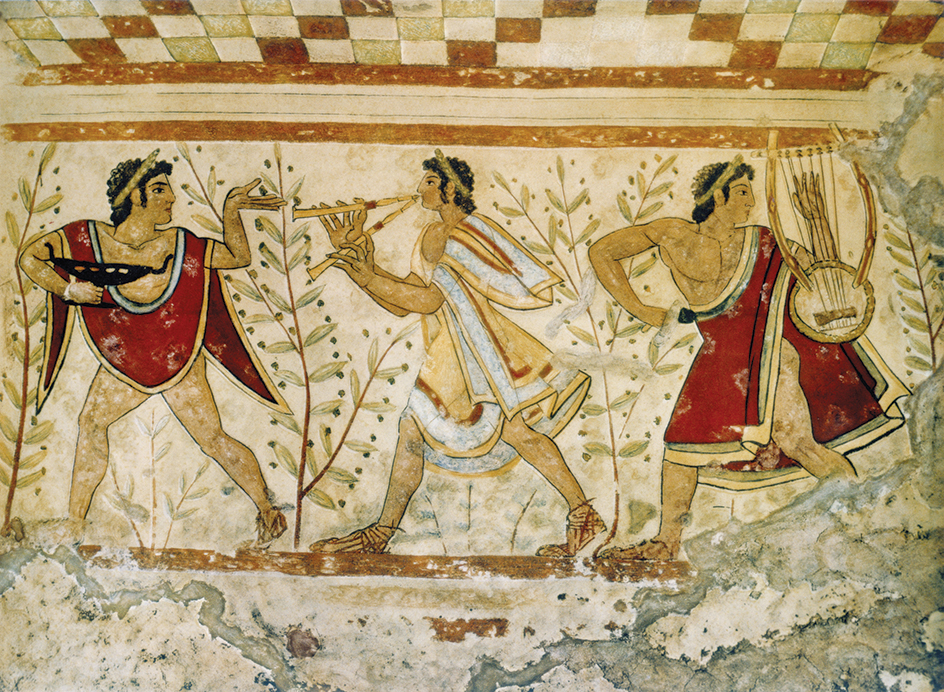
For hundreds of years, Roman conquerors expanded the republic. By 272 B.C., Rome controlled most of Italy. It soon became one of the most powerful states of the western Mediterranean. During the 200’s and 100’s B.C., Rome defeated its only major rival, the former Phoenician colony of Carthage, in a series of struggles called the Punic Wars (see Punic Wars). As a result of the wars, Sicily and Spain became Roman provinces. Rome also expanded into the eastern Mediterranean. In 148 B.C., the Romans made Macedonia their first eastern province. Two years later, they conquered Greece. In 55 and 54 B.C., the Roman general Julius Caesar invaded Britain. Other conquests followed until the original city of Rome had grown into an enormous empire. At its height, in A.D. 117, the empire covered about half of Europe, much of southwest Asia, and the entire north coast of Africa.
Roman territory included all the Greek lands of the Hellenistic Age. The Romans imitated Greek art and literature, made use of Greek scientific knowledge, and based their architecture on Greek models. Educated people throughout the Roman Empire spoke Greek. By imitating Greek accomplishments, the Romans preserved and passed on much Greek culture that otherwise might have been lost.
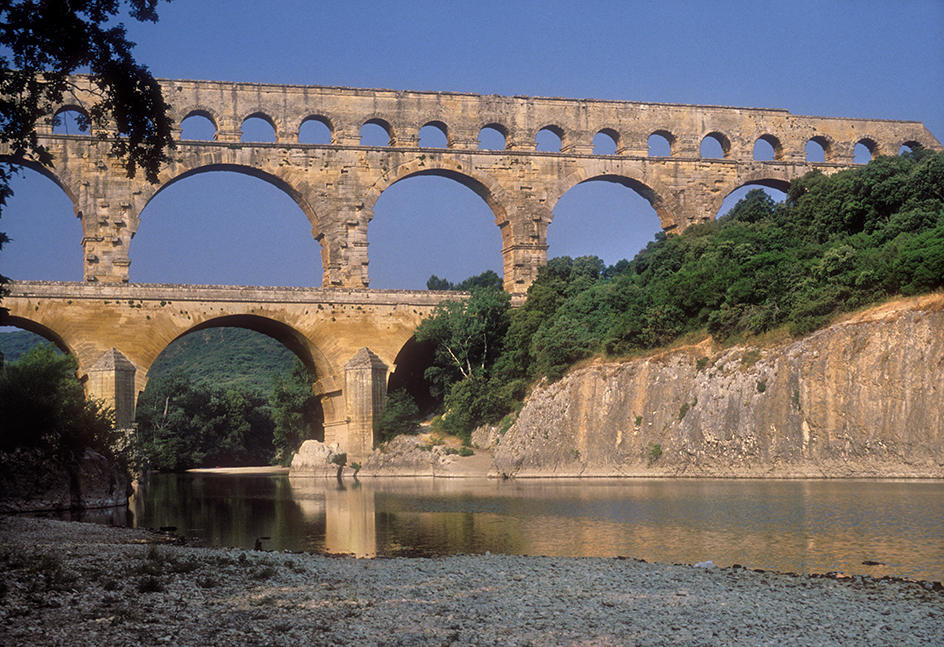
The Romans excelled in the art of government. One of their most important achievements was the empire itself, which provided a stable framework of government for many peoples with widely different customs. The Romans showed respect for these customs and won the good will of many of the peoples they governed. Rome was a republic until 27 B.C., when Augustus took supreme power. Augustus and his successors retained republican titles and forms of government, but Rome actually became a monarchy ruled by emperors.

A period of disorder followed Constantine’s death in 337. In 395, the Roman Empire split into two parts—the West Roman Empire and the East Roman, or Byzantine, Empire. The West Roman Empire soon fell and was replaced by small Germanic kingdoms, but the Byzantine Empire survived. For more information on the rise and fall of the Roman Empire, see Rome, Ancient.
The Mauryan Empire in India.
About 1500 B.C., bands of Aryans, an Indo-European people, began migrating to India. The Aryans came from the plains of central Asia through the mountain passes of the Hindu Kush. By 1000 B.C., they had taken over most of the valley of the upper Ganges River in northern India.
The Aryans never migrated to southern India, but their influence gradually extended over the entire country and greatly affected Indian culture. Sanskrit, the language spoken by the Aryans, is the basis of languages still spoken in India. Hinduism, the religion of most Indians today, is rooted in Indo-European beliefs. The Aryans divided their society into four main social classes that became part of the caste system of Indian society. These four classes were priests and scholars; rulers and warriors; merchants and professionals; and laborers and servants. See Caste.
At various times in its history, the Aryan territory was divided into many states. In one state, a prince named Siddhartha Gautama was born about 563 B.C. Gautama abandoned a life of luxury to seek religious enlightenment. He became a great religious teacher known to his followers as Buddha (Enlightened One). Gautama’s teachings are the foundation of Buddhism, one of the world’s major religions. See Buddhism.
By about 300 B.C., much of India was united for the first time under one dynasty, the Mauryan. The Mauryan Empire reached its peak under Emperor Ashoka, who ruled during the 200’s B.C. From his capital at Pataliputra (now Patna) in northern India, Ashoka controlled almost all India and part of central Asia. Ashoka supported Buddhism, which spread and prospered during his reign. He sent Buddhist missionaries to Ceylon (now Sri Lanka) and other countries. See Ashoka; Mauryan Empire.
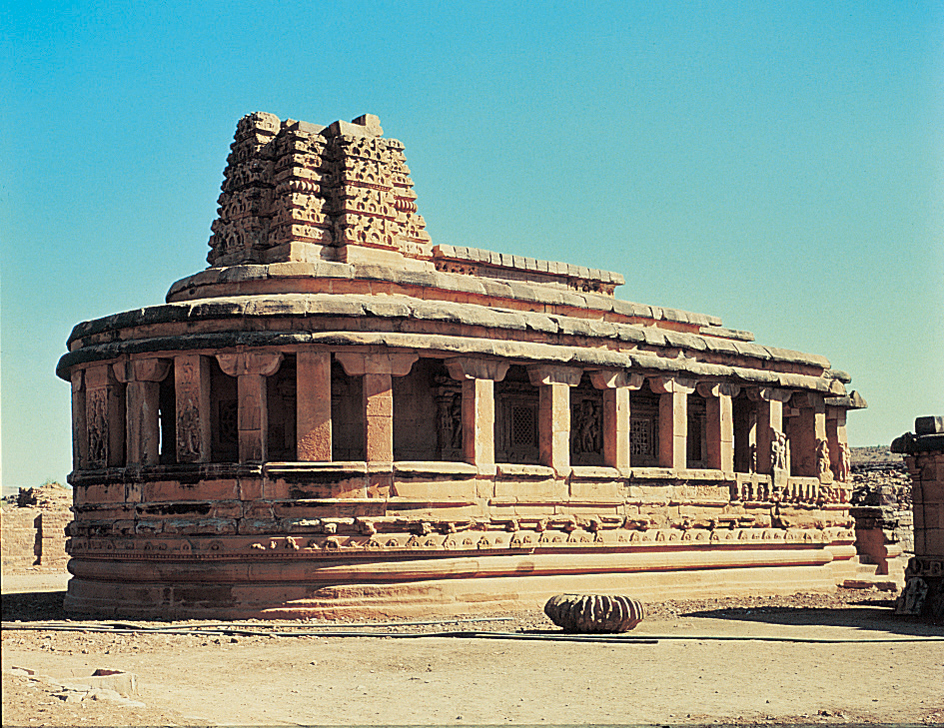
The unification of China.
About 1045 B.C., the Zhou people conquered the Shang from the west and established their own dynasty. The Zhou ruled until 256 B.C. The Zhou kings introduced the idea that they had been appointed to rule by Heaven. All later Chinese dynasties adopted that idea. From its beginning, the Zhou dynasty directly controlled only part of northern China. The rest of the kingdom consisted of semi-independent states. As time passed, the lords of these states grew increasingly powerful and so weakened the dynasty. In 771 B.C., the Zhou were forced to abandon their capital, near what is now Xi’an, and move eastward to Luoyang.
For hundreds of years after the Zhou moved their capital, fighting raged among the states for control of all China. Efforts to restore order to Chinese society led to the birth of Chinese philosophy during this period. The great philosopher Confucius stressed the importance of moral standards and tradition and of a well-ordered society in which people performed the duties of their stations in life. See Confucianism.
In 221 B.C., the Qin (also spelled Ch’in) state defeated the last of its rivals to the east. The Qin created the first unified Chinese empire controlled by a strong central government. The name China came from the name of their dynasty. The first Qin emperor, Shi Huangdi, standardized weights and measures and the Chinese writing system. He also built extensive irrigation projects and ordered the construction of massive defensive walls in the northern and western parts of his realm.
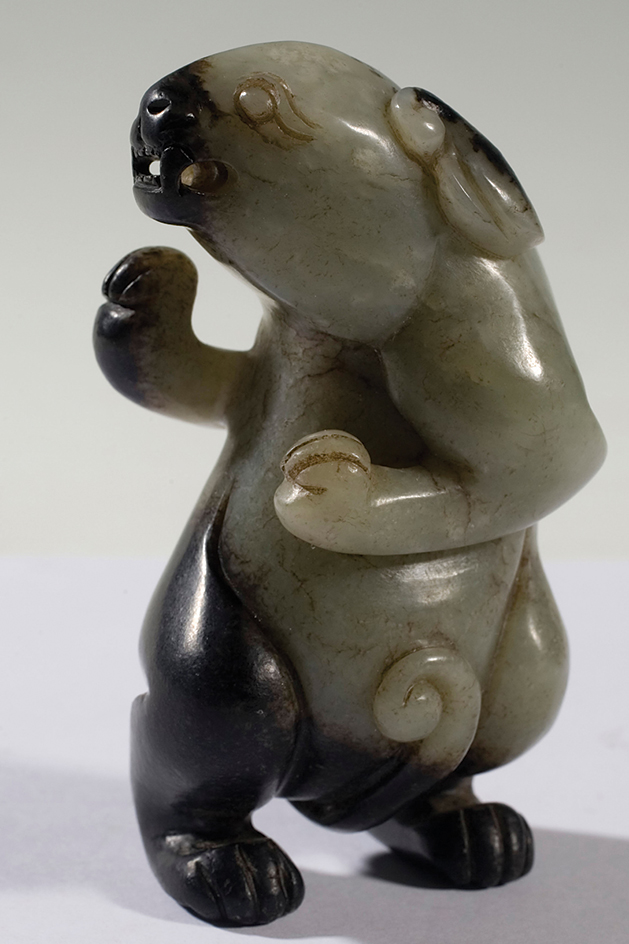
Han China expanded southwest to what is now Tibet. Han warriors also conquered parts of Vietnam and Korea and overcame nomadic peoples in the north and west. Political struggles among the Han leaders led to the dynasty’s collapse in A.D. 220. For the next 400 years, China was divided into warring states. See Han dynasty.
The world from 500 to 1500
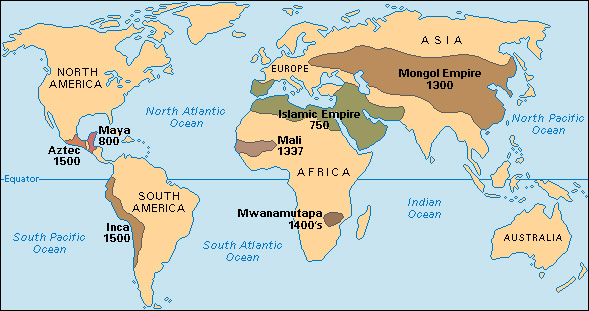
Great changes occurred in the old areas of civilization during the 1,000-year period. In western Europe, a number of separate states eventually arose from the disorder that followed the fall of the West Roman Empire. The East Roman, or Byzantine, Empire continued to survive and flourish. A new world religion, Islam, sprang up in Arabia and spread to many other parts of the world. Meanwhile, China continued to preserve its special way of life under a series of dynasties. Partly under influence from China, another Asian civilization appeared, that of Japan. In the Americas, civilizations developed without any outside influences.
In European history, the period from about the 400’s through the 1400’s is often referred to as the Middle Ages or the medieval period. The word medieval comes from the Latin words medium, meaning middle, and aevum, meaning age. The terms Middle Ages and medieval period made sense to later Europeans who looked back on those years as a distinct period in the middle of their history between the civilizations of ancient Greece and Rome and the start of modern times. But the terms cannot be applied to world history as a whole because the histories of many parts of the world have no connection with ancient Greece and Rome.
Medieval Europe.
By A.D. 400, many Germanic peoples from the east had settled within the West Roman Empire. In 476, a Germanic chieftain named Odoacer overthrew the last emperor, Romulus Augustulus. By that time, Germanic leaders had carved kingdoms out of all the West Roman provinces. They adapted some features of Roman government, but their kingdoms and government were on a much smaller scale.
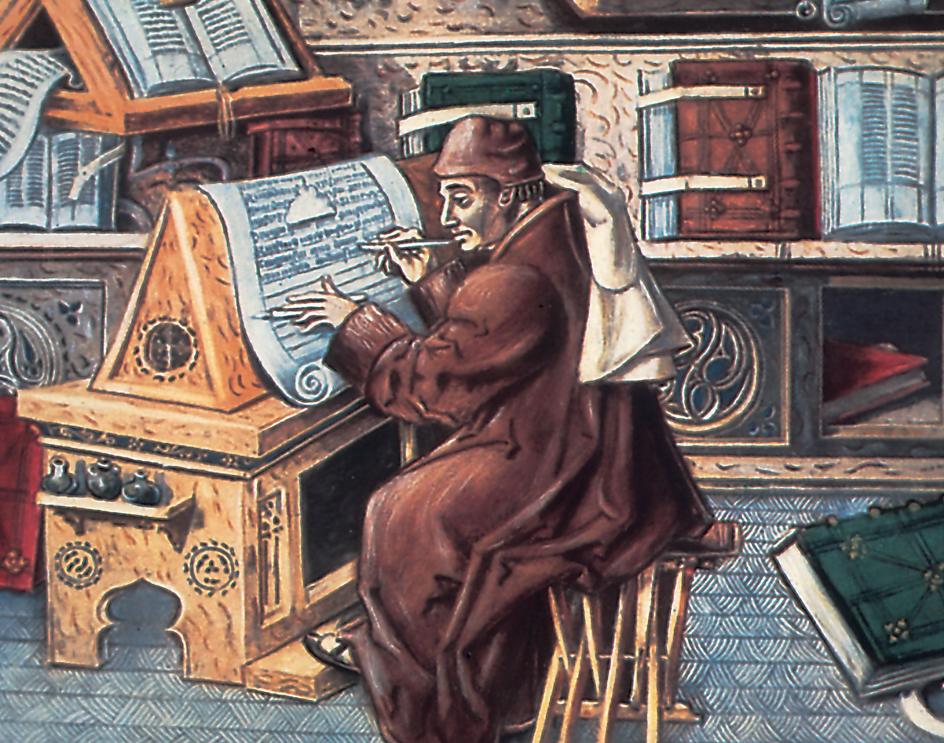
For hundreds of years after the fall of the West Roman Empire, the Germanic kings had great difficulty defending themselves against invaders. The invaders included Arabs from the south, Vikings from the north, and Magyars and Avars from the east. During these troubled times, powerful lords who owned most of the land gave some of their holdings to less wealthy nobles in return for pledges of allegiance. These lesser nobles, called vassals, swore to fight for the lord when he needed their help. Peasants worked the fields of the lords and their vassals. The power of the strongest lords rivaled that of the kings, who sometimes could exercise only limited authority beyond their personal estates.
During the 1000’s, many lords established strong governments and achieved periods of peace. Trade revived along the old land routes and waterways used by the Romans. Towns sprang up and prospered along the trade routes. The peasants learned better farming methods and gained new farmland by clearing forests and draining swamps. The population rose. Learning and the arts thrived as trade brought increasing contact with the advanced Byzantine and Islamic civilizations. During the 1100’s and 1200’s, the first European universities were established.
The people of the medieval towns often supported the kings against the lords. The townspeople agreed to pay taxes to the kings in return for protection and freedom. During the 1300’s and 1400’s, some kings became increasingly powerful. They began to extend their authority over the lords. By 1500, France, England, Spain, and Portugal had become unified nation-states ruled by monarchs. For more information about medieval Europe, see Middle Ages.
The Byzantine Empire

Christianity flourished in the Byzantine Empire. The Byzantine church was the chief civilizing force among the Slavic peoples of southeastern Europe and Russia. Byzantine missionaries converted the Slavs to Christianity and invented a script in which the Slavic languages were written down. The church in Constantinople was united with the church in Rome for many years. But rivalries developed between the churches, and they drifted apart. The Western Church eventually became known as the Roman Catholic Church. The Eastern Orthodox Churches developed out of Byzantine Christianity. See Eastern Orthodox Churches.
The Byzantine Empire reached its greatest extent under Emperor Justinian, who came to the throne in 527. His empire included Italy, much of southeastern Europe, part of Spain, much of southwest Asia, and lands along the north coast of Africa. At the command of Justinian, Byzantine scholars collected and organized the many laws of the ancient Romans. The resulting code of laws, called the Justinian Code, clarified the laws of the times and is today the basis of the legal systems of many countries (see Justinian Code). Art and architecture flourished during Justinian’s reign. The Byzantines constructed domed cathedrals with ornately decorated interiors. One of these cathedrals is the magnificent Hagia Sophia built by Justinian in Constantinople. See Byzantine art; Hagia Sophia.
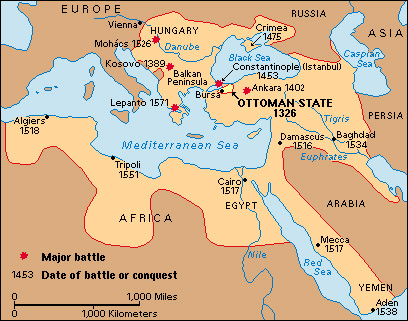
The Islamic world.
In the 600’s, Islam, a new religion based on the teachings of Muhammad, began in Arabia. Muhammad was born about 570 and grew up in Mecca, a major trading center on the Arabian Peninsula. At that time, many Arabs believed in nature gods and prayed to idols and spirits. But Muhammad urged the Arabs to worship one God. The Meccans rejected Muhammad’s teachings and persecuted him and his followers. In 622, Muhammad and his disciples fled to the city of Medina (then called Yathrib). Muhammad’s flight is called the Hijra, also spelled Hijrah or Hegira. The Muslim calendar is dated from the beginning of the year in which the Hijra took place. The people of Medina accepted Muhammad as God’s messenger. By 630, Muhammad and his followers had captured Mecca.
After Muhammad’s death in 632, authority to head the Islamic community passed to religious leaders later called caliphs. The first caliphs were members of Muhammad’s family. Under their leadership, Islam became a great conquering force. The Muslim armies defeated the tribes of southern Arabia and then spread north to Palestine, Syria, Mesopotamia, and Persia. In 661, the caliphate passed to another family, the Umayyads, who established their capital at Damascus. The Umayyad caliphs led the Muslim Arabs to new victories. By the early 700’s, the Arabs had conquered Rhodes, Sicily, northern Africa, and Afghanistan. Muslim forces had also pushed into Spain and India and reached the borders of China.
In 750, the Abbāsids became the caliphs of the expanding Islamic world. They moved the capital to Baghdad. Under the Abbāsids, Islamic civilization reached its greatest heights. Baghdad became a huge city, rivaling Constantinople in wealth and population. Islamic art and architecture flourished. Many Islamic academies and universities were founded.

The Abbāsid caliphate declined during the 900’s as peoples from central Asia began invading southwest Asia. Some of these peoples were Turks who had been converted to Islam. During the early 1300’s, the Ottomans, who had settled in Anatolia (now Turkey), became the military leaders of the Islamic world. After the Ottomans seized Constantinople in 1453, they made the city the capital of their empire. By 1700, the Ottoman Empire covered southeastern Europe, southern Russia, part of northern Africa, and much of southwest Asia. See Ottoman Empire.
For more details on the history of the Islamic world, see Muslims.
China.
From 500 to 1500, China had a highly productive agricultural economy. Food surpluses enabled craftworkers to produce high-quality silk and porcelain that became popular throughout much of the Eastern Hemisphere. Merchants flocked to China by camel caravan across central Asia, and mariners from as far away as India and Persia sailed to China through the Indian Ocean. During the Tang dynasty (618-907) and the Song dynasty (960-1279), China enjoyed great prosperity and cultural accomplishment.
The Tang and Song rulers continued to use the system of civil service examinations based on Confucianism that had begun hundreds of years earlier during Han times. Successful candidates for government office thus shared a common body of beliefs and a respect for traditional ways. Cities and towns grew rapidly during the Tang and Song periods. The Tang capital at Chang’an (now Xi’an) had a population of more than a million people. Literature, history, and philosophy flourished under the Tang and Song dynasties. During the Tang period, the Chinese invented gunpowder and block printing. Chinese inventions during the Song period included a type of handheld gun, the magnetic compass, and movable type for printing. See Tang dynasty; Song dynasty.
During the 1200’s, Mongol warriors swept into China from the north. The Mongol leader Kublai Khan established the Yuan dynasty, which lasted from 1279 to 1368. The Mongol period marked the first time that all China had come under foreign rule. Kublai Khan encouraged commerce and cultural exchange with other peoples. During Yuan times, Europeans became increasingly interested in China as a result of the reports of travelers and traders. The most enthusiastic reports came from Marco Polo, a trader from Venice. Rebellions drove the Mongols from China during the mid-1300’s. In 1368, Chinese rule was reestablished under the Ming dynasty, which held power until 1644. See Mongol Empire.
The rise of Japanese civilization.
The development of Japanese civilization was greatly influenced by the neighboring Chinese culture. During the 500’s, Confucianism and Buddhism reached Japan from China. The Japanese borrowed the Chinese system of writing and adopted some Chinese ideas of government and administration. Japanese government, like Chinese government, centered on an emperor. Beneath the emperor, Japanese society was divided into various clans (related families).
During the late 700’s and early 800’s, the Fujiwaras, an aristocratic clan, rose to power in Japan. The Fujiwaras gained control over the emperor and his court by intermarrying with the imperial family. Under the Fujiwaras, the court nobility enjoyed a life of splendor and luxury. The people of Japan began to cast off Chinese cultural influences. Some of the first masterpieces of Japanese literature were written during the Fujiwara era. The Japanese also produced fine ceramics and lacquerware and developed such arts as flower arranging, landscape gardening, and silk weaving. Japanese exports gradually began to appear in the markets of China and southeastern Asia. The Fujiwara clan ruled Japan about 300 years. During that time, the emperors lost all real power, though they still officially reigned.
During the 1000’s, civil wars between rival nobles brought an end to Fujiwara rule. Another powerful clan, the Minamoto, seized control of the imperial court in 1185. The Minamoto leaders established a form of military government called a bakufu or shogunate. The emperor remained in retirement, and a Minamoto shogun (military commander) ruled in his name (see Shogun). The Minamoto bakufu collapsed in the early 1300’s, when Japan was again torn by violent civil wars. The wars slowed the growth of cities and towns and weakened the society. But Japan remained safe from attack by foreign powers because of its isolated island position. The Mongols tried to invade Japan in 1274 and 1281, but both attempts failed because of typhoons in the Sea of Japan (also called the East Sea). See Japan (History).
The age of invasions of India.
After the Gupta Empire fell in about 500, India broke up into many small kingdoms. From then until the early 1500’s, India suffered repeated invasions from the northwest. In the early 700’s, Muslim invaders from Arabia swept across northwestern India but were eventually overcome by Indian forces. During the late 1100’s, Muslim Turks from central Asia conquered the Indus Valley. By 1206, they had established a sultanate (government by a sultan) in Delhi. The Delhi Sultanate soon controlled all northern India. During the sultanate, many Muslims came to India to serve as soldiers, government officials, merchants, and priests. Muslim holy men converted many Indians to Islam. See Delhi Sultanate.
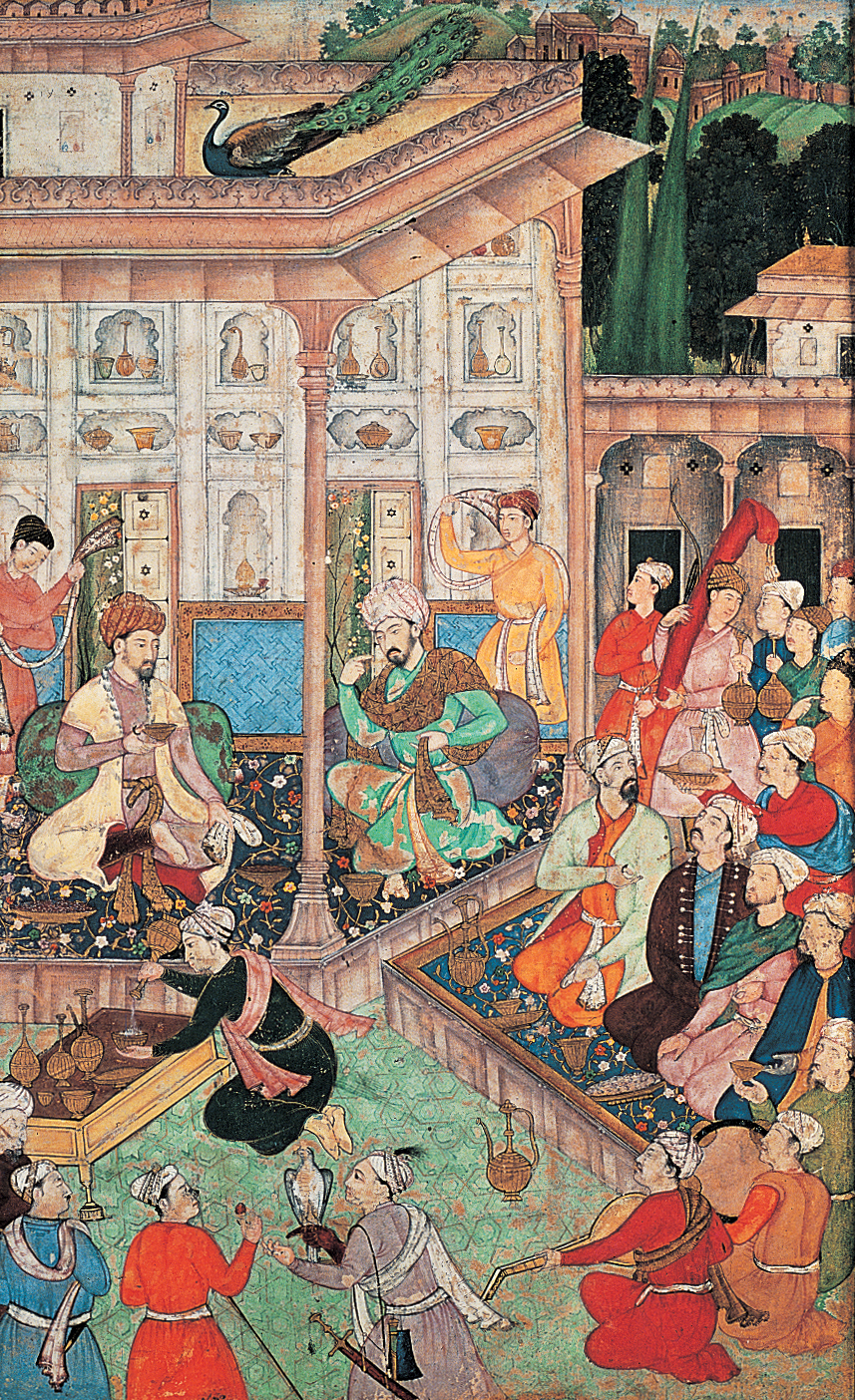
African civilizations.
The Muslim Arabs completed their conquest of northern Africa by 710. For hundreds of years, the Islamic faith and culture spread to other parts of Africa. Camel caravans that crossed the Sahara brought northern Muslims into contact with western Africa. Muslim traders who sailed the Indian Ocean converted the peoples living along the east coasts of what are now Somalia, Kenya, and Tanzania. Black African empires developed and prospered along some of the major trade routes.
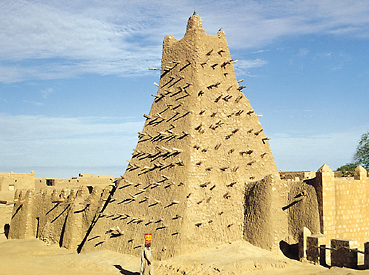
Islamic influence did not extend into southern Africa. Much of the south was originally settled by peoples who spoke Bantu languages. About the time of Christ, these peoples began migrating southward from what is now the border region between Nigeria and Cameroon. Their migrations lasted over 1,000 years.
On the east coast of Africa, the Bantu peoples came into contact with traders from the Persian Gulf region who wanted to buy gold, copper, iron, ivory, and enslaved people. Several large trading empires developed in southeastern Africa, but little is known about them. One empire, the Mwanamutapa Empire, arose during the 1400’s in what are now Mozambique and Zimbabwe. The city of Zimbabwe served as the empire’s capital. During the late 1400’s, the Changamire Empire conquered the Mwanamutapa and took over the capital. Massive towers and walls from a royal residence and burial place built during Changamire times still stand on the site of the city. See Zimbabwe (History).
Civilizations in the Americas.
The first civilizations in the Americas arose in Central America and in what are now Mexico and Peru. The Maya people of Central America and Mexico built a sophisticated agricultural society. Between about 250 and 900, the Maya built religious centers consisting of palaces, pyramids, temples, and terraces. The Maya studied astronomy and invented an accurate yearly calendar. They also developed an advanced form of writing. For reasons still unknown, Maya civilization began to decline during the 900’s. Many Maya sites were abandoned. See Maya.
From about 900 to 1200, the Toltec were the dominant people in the central Mexican highlands. By the early 1400’s, the Aztec replaced the Toltec as the most powerful people in central Mexico. The Aztec built a magnificent capital city, Tenochtitlan, on the site of present-day Mexico City and established a mighty empire. The Aztec devoted much of their time to religious practices. Human sacrifice was a central feature of their religion. The Aztec believed that the shedding of blood was necessary for continued agricultural productivity. See Toltec Indians; Aztec.
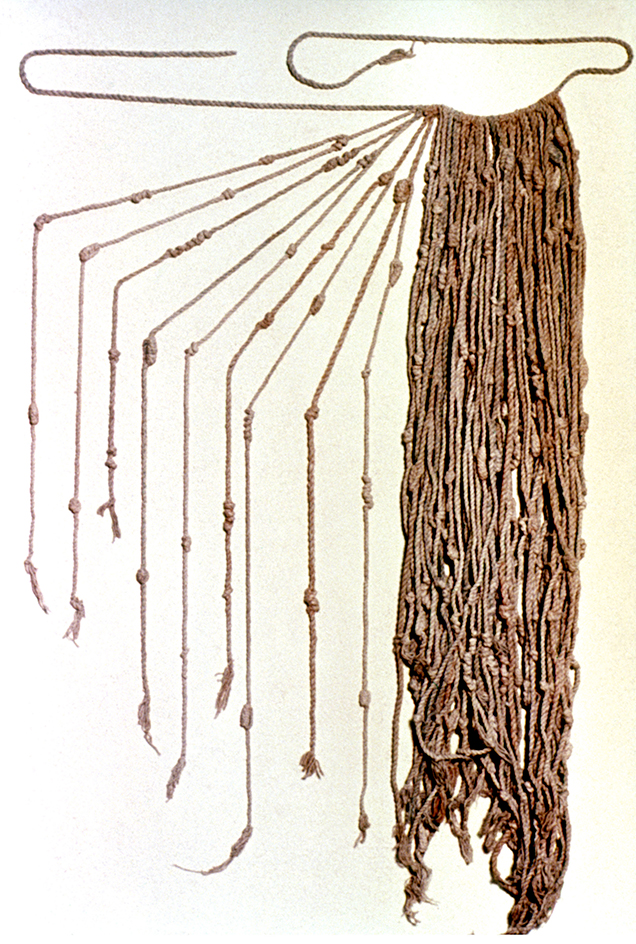
The spread of European civilization
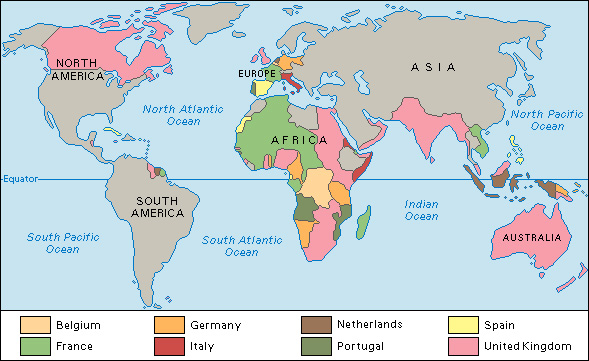
A number of factors contributed to the wide expansion of European influence. An age of European exploration during the 1400’s and 1500’s led to the founding of European colonies in Africa, Asia, and the Americas. Thousands of Europeans migrated to these colonies. Industrialization began in Europe during the 1700’s, and the continent soon became the manufacturing center of the world. The European nations established more and more colonies overseas to serve as markets for their manufactured products and as sources of raw materials for industry. Growing trade with these colonies brought increasing wealth and power to the continent. Political rivalries among the European states also encouraged them to expand their empires abroad. Advances in technology, such as better ships and weapons, helped the Europeans conquer new territories.
The Europeans often introduced their arts and technology and their systems of law, government, and education into the various areas where they settled. In this way, the ideas and skills of European civilization became more widespread than those of any other civilization in history.
The Renaissance.
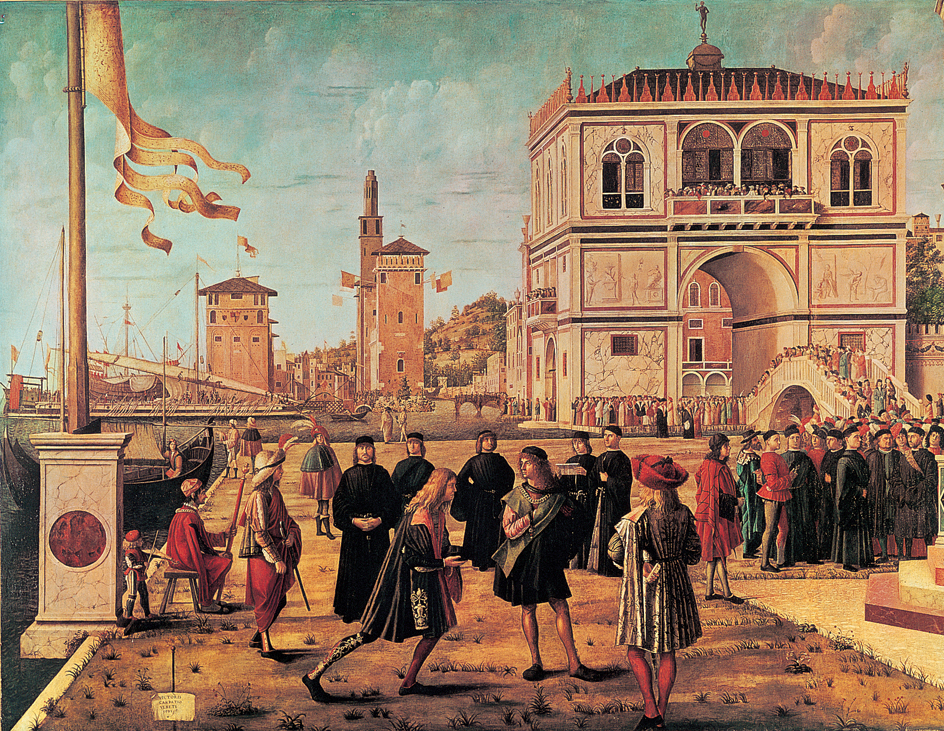
The Renaissance began in Italy in the early 1300’s. It spread throughout most of Europe during the 1400’s and 1500’s. Writers of the period described human feelings and situations that people could easily understand. Renaissance artists tried to capture the dignity and majesty of human beings in lifelike paintings and sculptures. Architects designed many buildings that incorporated elements of classical style. Many world masterpieces of architecture, literature, painting, and sculpture were created during the Renaissance. See Renaissance.
Other changes that occurred during the Renaissance affected the Christian church itself. During the early 1500’s, a religious movement called the Reformation led to the birth of Protestantism. The Reformation followed many earlier attempts by religious reformers to correct abuses that had developed within the Roman Catholic Church. In 1517, Martin Luther, a German monk and theology professor, set off the reform movement by challenging a number of church teachings and practices. Luther’s criticisms gradually led him and his followers to break completely with the Catholic Church.
By 1600, reformers had established Protestant churches in about half of western Europe. Many Protestant groups emerged. The Protestant movement encouraged Roman Catholic leaders to work toward reform and renewal in their own church. This movement led to the Counter Reformation, which ended many abuses in the Roman Catholic Church and greatly strengthened the authority of the pope. Religious rivalries led to bitter conflicts and even religious wars. By the mid-1600’s, however, Protestants and Catholics alike had become weary of conflict, and they began to move toward religious toleration. See Reformation; Counter Reformation.

The age of exploration.
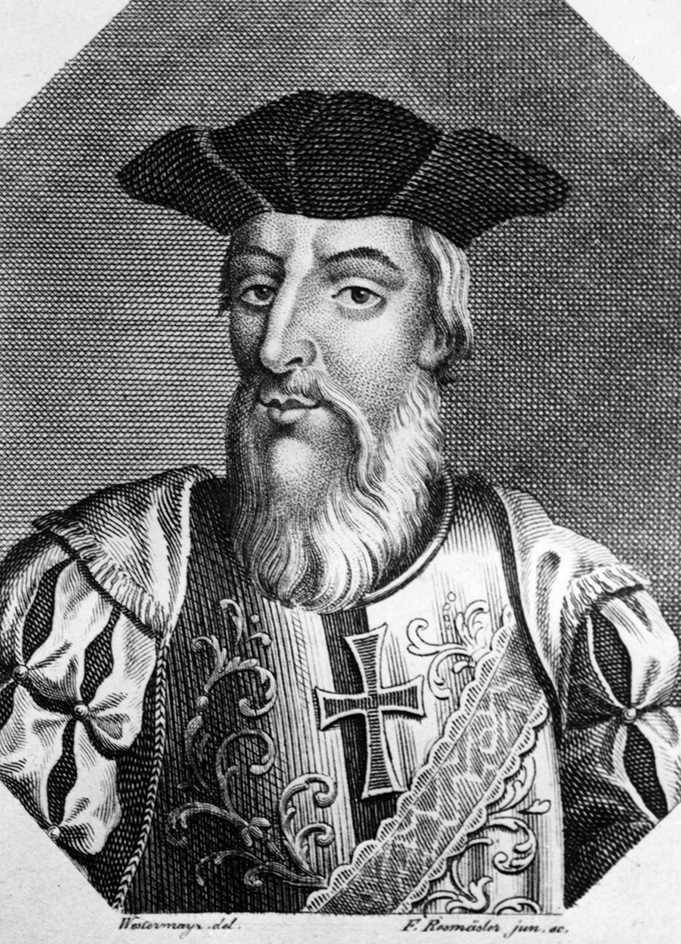
During the 1500’s and 1600’s, Europeans continued to gain geographical knowledge. In the early 1500’s, Ferdinand Magellan, a Portuguese navigator in the service of Spain, set out on an expedition to sail around the world. Magellan was killed on the journey, but one of his ships completed the voyage. Sailors from France, England, and the Netherlands led the search for shorter routes to Asia—either a Northwest Passage across North America or a Northeast Passage north of Europe. Explorers slowly began to work their way through the land mass of America. See Exploration (The age of European exploration).
The discovery of new territories provided opportunities for the expansion of European commerce. By 1700, Europeans were trading throughout the world, and some European lands had acquired colonial empires. The colonies provided Europeans with coffee, cotton fabrics, hardwoods, spices, sugar, and other products. New crops, such as potatoes and tobacco, were introduced into Europe from America. A large trade in enslaved people developed with Africa. In addition, a continuous flow of gold and silver from the Western Hemisphere, also called the “New World,” enabled Europeans to increase their trade with India and China, where demand for the precious metals was high.
The colonization of America.
The search for gold drew many of the first Spanish explorers and conquistadors (conquerors) to the Western Hemisphere. The most famous conquistador was Hernán Cortés. In 1519, he landed in Mexico, marched his army to the Aztec capital at Tenochtitlan, and took the Aztec emperor captive. The Aztec rebelled in 1520. They were finally defeated in 1521. Cortés then claimed Mexico for Spain. In 1533, another Spaniard, Francisco Pizarro, conquered the wealthy empire of the Inca people in Peru. See Cortés, Hernán; Pizarro, Francisco.
Except for members of the Spanish clergy, few Spaniards had respect for the Indigenous (native) American peoples and their ways of life. They made the Indigenous people give them a fortune in gold and other riches and forced them to work in their mines and on their plantations. Millions of Indigenous people died of mistreatment or of smallpox and other diseases introduced to the Americas by the Spaniards.
Spanish rule rapidly expanded in the Americas. By 1700, Spain controlled Mexico, Central America, and most of South America. The Spaniards established cities and universities throughout their territory. European government, the Spanish language, and the Catholic Church became dominant in most of Latin America. The population of the colonies rose as more settlers arrived and Indigenous people acquired some resistance to European diseases. Many Spaniards and Indigenous people intermarried, producing the beginning of a population of mixed ancestry. However, the ruling class of the colonies consisted only of people of unmixed European ancestry.
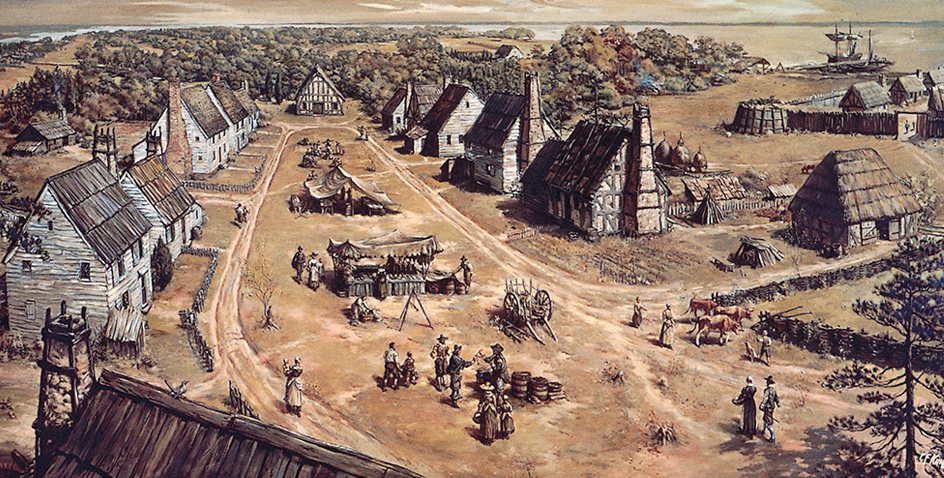
The English colonists were soon able to grow enough food to support themselves. They also produced tobacco and other valuable exports to pay for imports from England. But unlike the Spanish colonies, the English colonies had no silver or gold. In addition, the English settlers in North America did not find densely populated Indigenous societies like those in Mexico and Peru. At first, the Indigenous people and the settlers had friendly relations. But as more and more settlers claimed greater amounts of Indigenous hunting grounds, wars broke out between the two groups. See Indian wars (Colonial days).
The Islamic empires.
Parts of Europe and Asia remained under control of the Ottoman Empire until the early 1900’s. The Ottoman Empire never had a strong central government. Ottoman governors ruled the provinces of the empire. Their chief tasks included collecting taxes and raising armies. But they interfered as little as possible in the lives of the conquered peoples. For example, Christians and Jews could practice their faiths as long as they paid their taxes. The subject peoples thus continued to be divided into separate communities and felt no loyalty to their Ottoman rulers. This lack of unity weakened the empire.
The Ottomans could not control some areas of their empire. Mesopotamia was especially difficult to govern. For nearly 200 years, this valley between the Tigris and Euphrates rivers was the site of warfare between the Ottomans and another Islamic power, Persia. A new dynasty, the Safavid, had developed in Persia in the early 1500’s. The greatest Safavid king was Shah Abbas, who came to the throne in 1587. He successfully fought the Ottomans and Uzbek tribes from Turkestan. Shah Abbas and his successors strongly supported the development of the arts. Isfahan, which became the Safavid capital in 1598, was known as one of the world’s most beautiful cities. Safavid power began to decline after Shah Abbas died in 1629. It ended in 1722, when armies from Afghanistan invaded Persia and captured Isfahan. See Safavid dynasty.

At first, the spread of European influence had little effect on the Islamic world, though trade gradually increased between the European lands and the Islamic empires. But as the Islamic powers declined, the Europeans took advantage of the situation and began to assume control of Islamic lands. By 1900, European nations dominated most of the Islamic world. The French established themselves in northern Africa. The Dutch took Indonesia. The United Kingdom occupied Egypt and the Sudan, set up an empire in India, and ruled Malaya. During the 1900’s, Italy seized Ottoman territories in northern Africa and along the eastern shores of the Mediterranean Sea.
Developments in China and Japan.
The Ming dynasty, which had come to power in China in 1368, began to decline during the 1500’s. Rebellions in outlying provinces troubled the empire, and Indochina and other distant dependencies slipped out of its control. The Ming emperors looked down on all things foreign. They regarded the European traders who visited China as inferiors. But some rights were granted to the Europeans as the Ming dynasty weakened. The Portuguese were allowed to establish a settlement at Macau, on the southeast coast of China, in 1557. A European community later grew up in the city of Canton (now called Guangzhou), a major center of foreign trade with China.
In 1644, the Ming asked the Manchus, a seminomadic people from Manchuria, for help in putting down rebellions within the empire. The Manchus then invaded China—but only to establish their own dynasty, the Qing, on the throne. The Manchus ruled China until 1912. They had great respect for Chinese civilization and did little to change Chinese life or government. The Manchu rulers pushed back Russian advances in the Amur River Valley, established control over Tibet, regained parts of Indochina, and added Korea to their territory. During the 1700’s, contacts with Europeans multiplied, and Christian missionaries were welcomed at the Manchu capital, Beijing. The Manchus admired the Europeans’ scientific knowledge and their skills in mapmaking and the manufacture of guns, but they did not wish to imitate European ways of life.
In Japan, the Tokugawa family seized power in 1603. The Tokugawas ruled as shogun for more than 250 years. They were determined to end the civil wars that had troubled the country for years and restore order to Japanese society. Under Tokugawa rule, Japan was divided into about 250 regions, each headed by a lord who swore allegiance to the shogun.
European traders and Christian missionaries had begun arriving in Japan during the 1500’s. But the Tokugawa rulers feared that the missionaries might soon bring European armies with them to conquer Japan. In the early 1600’s, they ordered all missionaries to leave the country. They also tried to force all Japanese converts to give up their new faith. Those who refused were persecuted or killed. By 1640, Christianity had been almost eliminated.
The Tokugawa rulers also believed that it was necessary to restrict contact with European merchants, who, it was believed, might serve the interests of European conquerors. In the 1630’s, the government cut its ties with all European merchants except for a small community of Dutch traders, who had shown no interest in promoting Christianity or interfering in Japanese politics. The Dutch were permitted to live on the tiny island of Deshima in the harbor at Nagasaki. Although the Tokugawas sharply restricted Japanese trade with Europe, they permitted flourishing trade with China and Korea.
The rise of democracy and nationalism.
During the 1700’s and 1800’s, most countries in the Western world were affected by two powerful political forces—democracy and nationalism. During this period, many peoples won the right to take part in their governments. Nationalistic feelings—particularly the desire of people who shared a common culture to be united as a nation—led to the formation of many new states.
In some areas, the movement toward democracy and nationalism triggered revolts against existing political systems. One of the most important revolts was the American Revolution. Relations between the United Kingdom and its colonies in America began to break down in the mid-1700’s. The colonists, who had enjoyed a large degree of self-government, wanted even greater freedom. They resented efforts by the British government to tighten its control over the colonies. The American Revolution began in 1775. On July 4, 1776, the colonists issued the Declaration of Independence, in which they declared their freedom from British rule and the formation of a new nation, the United States of America. The British were defeated in the war, and in 1783, they acknowledged the independence of the colonies. The U.S. Constitution, adopted in 1788, officially established the new nation as a republic. See American Revolution; Declaration of Independence.
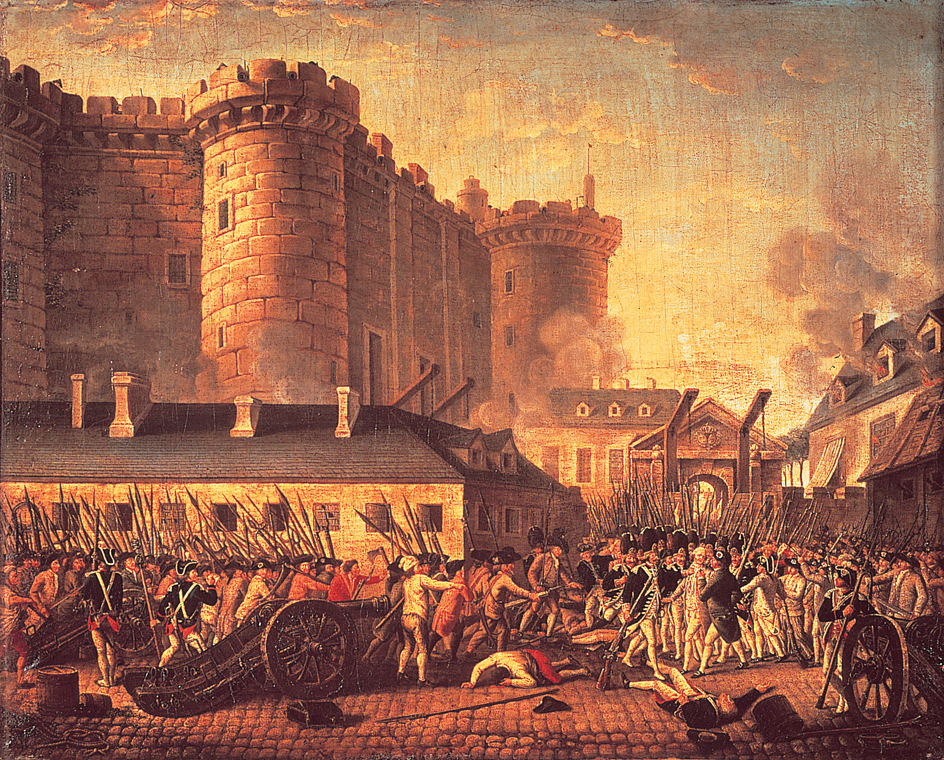
During the French Revolution, Napoleon Bonaparte, a professional soldier, began to attract notice as a successful general. In 1799, he overthrew the revolutionary government and seized control of France. Napoleon made himself emperor in 1804. Under his leadership, the French came to control most of western Europe. But Napoleon lost much of his army when he invaded Russia in 1812. In 1815, allied European forces crushed Napoleon in the Battle of Waterloo, ending his attempt to rule Europe. See Napoleon I.
From late 1814 through early 1815, European leaders held a series of meetings called the Congress of Vienna. By that time, the ideas of the French Revolution had spread throughout Europe. The great rulers at the congress feared the effects of these ideas and wanted to smother liberal and nationalistic feelings among their subjects. They restored monarchies in Italy, Spain, and several other countries where they had been overthrown by Napoleon. They also approved the restoration of the French monarchy. But the congress failed to halt the spread of liberalism and nationalism in the long run. See Vienna, Congress of.
By 1880, nearly every European nation had a constitution. In some, all adult males had received the right to vote. Germany and Italy, which had been divided into many small states, were each united as a nation under a constitutional monarchy. Many new nations with constitutional governments appeared in southeastern Europe as the Ottoman Empire began to crumble. The United States had survived the crisis of its Civil War (1861-1865), when its unity as a nation had been at stake. By 1900, many people believed that democracy and nationalism would continue to spread and eventually solve all the world’s political problems. But in some areas, these forces had already started to create new problems. Nationalism posed serious threats for Russia and Austria-Hungary, which governed peoples of many different nationalities. Quarrels among the new nations of southeastern Europe also threatened to disrupt peace.
The Industrial Revolution.
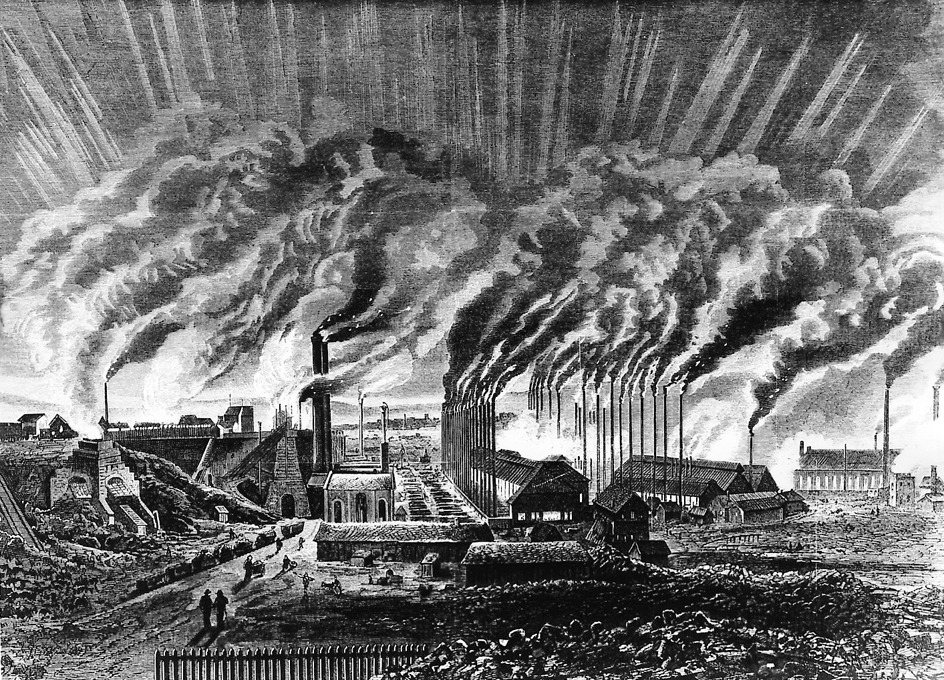
The Industrial Revolution transformed human life more dramatically than any other change since the development of agriculture. Before the Industrial Revolution, most Europeans lived in the countryside. Towns and villages served chiefly as market centers for the farmers. But as factories appeared, towns grew into industrial cities. People streamed into the cities to take factory jobs. Better transportation and communication between cities became necessary. Many railroads, roads, and waterways were built. By 1837, invention of the telegraph had furnished fast long-distance communication.
Industrialization brought many social changes. The middle class prospered and grew rapidly. Members of the middle class owned most of the factories, hired the workers, and operated the banks, mines, and railroads. They believed that business should be regulated by supply and demand, largely without government control. This idea forms the basis of capitalism, an economic system in which the chief means of production are privately owned. During the early 1800’s, the United Kingdom began to develop the first capitalist economy. Capitalism soon spread to other industrial nations. See Capitalism.
Often, early factory workers were poorly paid and had to work long hours under unhealthful conditions. They could not form labor unions. Their working conditions were not regulated by law. In the growing industrial cities, housing could not keep up with the migration of workers from rural areas. Severe overcrowding resulted, and many people lived in extremely unsanitary conditions that led to outbreaks of disease. Unemployed workers rioted and destroyed machinery in an attempt to gain revenge against the factories they blamed for their joblessness. Employed workers joined in riots, went on strike, and formed illegal trade unions to fight for their rights.
Some people believed that the evils of industrialization resulted from capitalism. Socialism became the chief rallying point for many such people. The socialists wanted to put all industrial production under the control of the workers. From that basic idea, Karl Marx, a German writer and social philosopher, developed the theories of Communism. Marx believed that workers would be driven by the march of history to rise up against the wealthy and to establish socialist economic systems and classless societies. By 1900, many European socialists had accepted Marx’s ideas and belonged to political parties whose aim was the overthrow of the capitalist system. See Communism (Communism in theory); Marx, Karl.
During the 1800’s, workers in many countries won the right to form labor unions. Laws regulating working conditions were passed in the United States and the United Kingdom during the 1840’s. The United Kingdom and Germany pioneered in social legislation that provided accident, sickness, and unemployment insurance for industrial employees. By the late 1800’s, most industrial nations had laws that regulated working conditions and raised the workers’ standards of living.
Imperialism.
The Industrial Revolution contributed to a great rise in imperialism—that is, the political or economic control of one country over others—during the 1800’s. The industrialized nations acquired more and more colonies as they eagerly sought raw materials for their factories, markets for their manufactured goods, and opportunities for investment. Africa was one of the main areas of colonial expansion. By the late 1800’s, Belgium, France, Germany, Italy, Portugal, Spain, and the United Kingdom had divided up almost all of Africa. Only Ethiopia and Liberia remained independent.
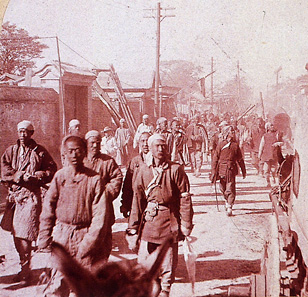
In Latin America, a series of wars of independence during the early 1800’s freed many colonies from European rule (see Latin America (The movement toward independence)). The United States, backed by the United Kingdom, acted to protect the new Latin American republics against European attempts to reestablish colonial rule. In 1823, U.S. President James Monroe issued the Monroe Doctrine, which warned European powers not to interfere in the affairs of the Western Hemisphere. See Monroe Doctrine.
The United States itself expanded into new areas during the 1800’s. As a result of the Mexican War (1846-1848), it gained Mexican territory that now covers California, Nevada, Utah, and parts of four other states. In 1867, the United States purchased Alaska from Russia. Spain surrendered Guam, Puerto Rico, and the Philippines to the United States after losing the Spanish-American War in 1898.
Imperialism affected the colonized peoples in various ways. In some areas, it brought economic development and raised living standards by introducing European agricultural, industrial, and medical techniques. Colonial rule also ended local wars in numerous lands. However, many imperialist nations took advantage of their colonies by exporting natural resources without providing economic benefits in return to most of the people. Colonial administrations often cared little about local customs and destroyed old ways of life. As time passed, injustices under the imperialistic system triggered nationalistic feelings, resistance movements, and demands for self-government among the colonized peoples. See Imperialism.
The world since 1900
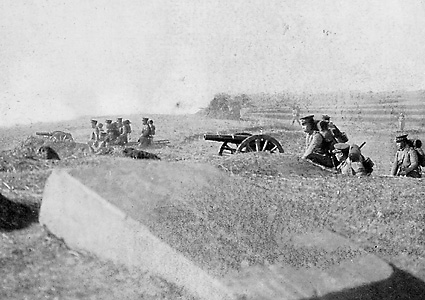
The world has seen dramatic political changes since 1900. The large colonial empires of the 1800’s have disappeared, and many new nations have emerged. Europe no longer dominates international affairs. After 1945, the United States and the Soviet Union ranked as the world’s superpowers. But serious economic problems contributed to a sharp loss of Soviet power after 1985, and the Soviet Union dissolved in late 1991. Since 1900, world leaders have worked to establish institutions, such as the United Nations (UN), that strive to promote international health, peace, and prosperity.
The world’s many peoples retain their unique beliefs and customs. But they increasingly trade with one another and share such cultural elements as clothing, food, and music. Migration has grown quickly since 1900 and has surged since the 1980’s. Powerful political and economic forces operate globally, and events in one country can quickly affect faraway lands.
The world wars.
War—fought on a greater scale than ever before—overshadowed world developments in the first half of the 1900’s. World War I raged from 1914 to 1918, and World War II from 1939 to 1945.
World War I broke out chiefly because of competition for colonial and economic power among European nations; the desire of national groups to gain independence; and military alliances that divided Europe. In the war, the Allies, which included France, Italy, Russia, and the United Kingdom, fought the Central Powers, which included Austria-Hungary, Germany, and the Ottoman Empire. The United States joined the Allies in 1917. In November 1917 (October on the old Russian calendar), a revolution in Russia established a Communist dictatorship there, and Russia withdrew from the war. The Allies gained victory in 1918. The Treaty of Versailles, signed in 1919, ended the war with Germany (see Versailles, Treaty of). The Allies signed separate treaties with the other Central Powers. See World War I.
World War I was fought at a terrible cost. Millions of men, women, and children were killed. Whole cities were destroyed. The economic damage was huge. The war brought about many changes in the political map of Europe. For example, Austria-Hungary and the Ottoman Empire broke up into separate national states. In Germany, the Weimar Republic replaced the monarchy.
The Treaty of Versailles required Germany to disarm, give up much of its territory, and pay war damages to the Allies. These requirements weakened Germany and caused great economic hardship. The situation became worse after 1929, when the Great Depression caused economic problems throughout the world.
Many German people felt that the Treaty of Versailles was excessively harsh and unfair. Adolf Hitler, head of the Nazi Party, won support in Germany by claiming that the Jewish people were responsible for the country’s defeat in the war and by promising to rebuild Germany as a mighty empire. In 1933, he became dictator of Germany. See Hitler, Adolf.
Loading the player...
Attack on Pearl Harbor
In 1938, Hitler ordered German forces to seize Austria and part of Czechoslovakia. In March 1939, Hitler’s forces took the rest of Czechoslovakia. On September 1, Germany invaded Poland and World War II began. Germany, Italy, Japan, and other Axis powers fought the Allies, which included Canada, China, France, the Soviet Union, the United Kingdom, and the United States. The United States entered the war in 1941, after Japan attacked U.S. military bases at Pearl Harbor in Hawaii. The war in Europe ended with Germany’s surrender in May 1945. In August 1945, U.S. planes dropped the first atomic bombs used in warfare on the Japanese cities of Hiroshima and Nagasaki. The next month, Japan signed the terms of surrender. See World War II.
The cost of World War II, both financially and in terms of human suffering and loss of life, was even greater than that of World War I. The political effects were also more sweeping. Europe lay in ruins. Allied forces occupied Germany, once Europe’s strongest nation. The major European countries were too weak to keep their colonies. The United States and the Soviet Union emerged as the world’s leading powers. Out of the horror of the war came attempts by nations to settle disputes peacefully. A new international organization, the United Nations, was established near the end of the war to provide a place where countries could work to resolve their differences (see United Nations).
The rise of Communism and the Cold War.
The Communist movement achieved its first major success when the Bolsheviks came to power in Russia in 1917. The movement grew quickly after World War II. In the late 1940’s, the Soviet Union imposed Communist governments in most countries of Eastern Europe, which Soviet armies had seized from German control after World War II. Germany consisted of West Germany, governed by freely elected representatives, and Communist-controlled East Germany. Chinese Communists founded the People’s Republic of China in 1949. In 1959, a Communist government came to power in Cuba, giving Communism a foothold in the Western Hemisphere. Communist movements also emerged in other Asian and Latin American countries.
Alarmed by Communist expansion, the United States and its allies began giving military and economic aid to non-Communist countries and pledged to help nations threatened by Communist take-overs. The struggle between the Communist world, led by the Soviet Union, and the non-Communist world, led by the United States, came to be called the Cold War. The United States and the Soviet Union formed armed coalitions to guard against military threats. The United States and its allies founded the North Atlantic Treaty Organization (NATO) in 1949. The Soviet Union and its allies responded by establishing the Warsaw Pact in 1955. See Cold War.
Loading the player...
Berlin Wall
Cold War tensions increased in the 1950’s and 1960’s. The Korean War (1950-1953) began when troops from Communist-ruled North Korea invaded South Korea (see Korean War). Cold War incidents occurred at times in the divided German city of Berlin. In 1961, the Communists built the Berlin Wall between democratic West Berlin and Communist-ruled East Berlin to prevent East Germans from escaping (see Berlin Wall).
The most serious Cold War incident was the Cuban missile crisis of 1962. In October of that year, the United States learned that the Soviet Union had installed missiles in Cuba that could launch nuclear attacks on United States cities. The crisis passed after the Soviet Union and U.S. President John F. Kennedy agreed that the Soviets would remove their missiles from Cuba in return for the removal of U.S. nuclear missiles from Turkey and Kennedy’s promise that the United States would not invade Cuba. See Cuban missile crisis.
The Vietnam War (1957-1975) grew out of Vietnam’s struggle for independence from France and was another major contest between Communists and non-Communists. After France pulled out of Vietnam, the United States entered to aid the non-Communists, and the Soviets increased their support for the Communist side. The war ended in a Communist victory. See Vietnam War.
The birth of new nations.
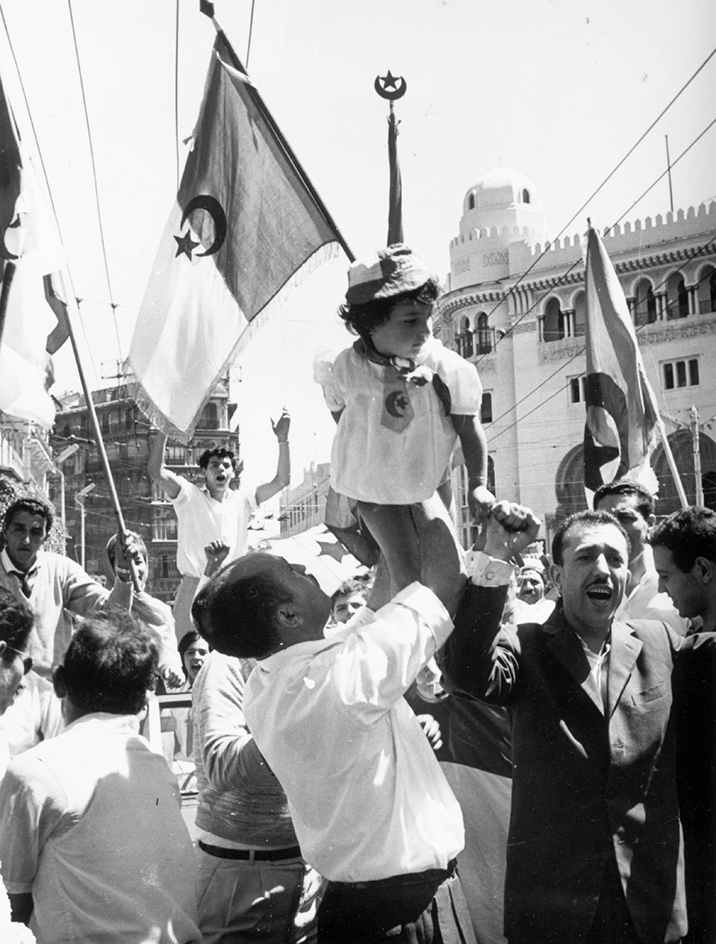
The end of colonialism complicated international politics. No longer did a few Western nations dominate the world. Some new nations experienced conflicts that might not have occurred in the colonial era. For example, serious tensions and wars have complicated relations between India and Pakistan, both formerly ruled by the United Kingdom. The formation of new nations also led to a large increase in the membership of the UN and greatly affected the balance of power in the UN. Many former colonies became part of a group of economically developing countries called the Third World. These countries had a majority of votes in the UN General Assembly. Many of them sought to develop policies that were independent of the Communist and non-Communist blocs (groups of nations). See Third World.
The new nations hoped independence would bring political stability and economic well-being. But most of them continued to face serious economic, political, and social difficulties. In some developing nations, religious or ethnic tensions have led to political division and civil conflict. Such grave problems as disease, food shortages, illiteracy, poverty, and rapid population growth have also troubled many of these countries. Most of the former colonies have had to depend on investment from wealthier countries to develop their economies. But this investment itself has frequently led to renewed political interference from the countries providing aid.
Many of the new nations had hoped that an end to colonial exploitation would automatically bring economic prosperity. Instead, they continue to face such grave problems as rapid population growth, poverty, illiteracy, disease, and food shortages. Most of the former colonies have found it almost impossible to develop their economies without investment from wealthier countries. But this investment has often led to renewed political interference from the countries providing aid.
The end of the Cold War.
Relations between Communist and non-Communist nations began to improve in the 1970’s. Soviet and U.S. leaders embarked on a policy of detente, meaning a relaxation of political tensions. At the same time, the United States and China worked to establish normal diplomatic relations.
Cold War tensions fell even more sharply in the late 1980’s. In 1987, Soviet leader Mikhail Gorbachev and U.S. President Ronald Reagan signed a treaty calling for the destruction of many U.S. and Soviet nuclear missiles. Tensions decreased further in 1989, when the Soviet Union withdrew military forces from Afghanistan, which the Soviet military had invaded in 1979.
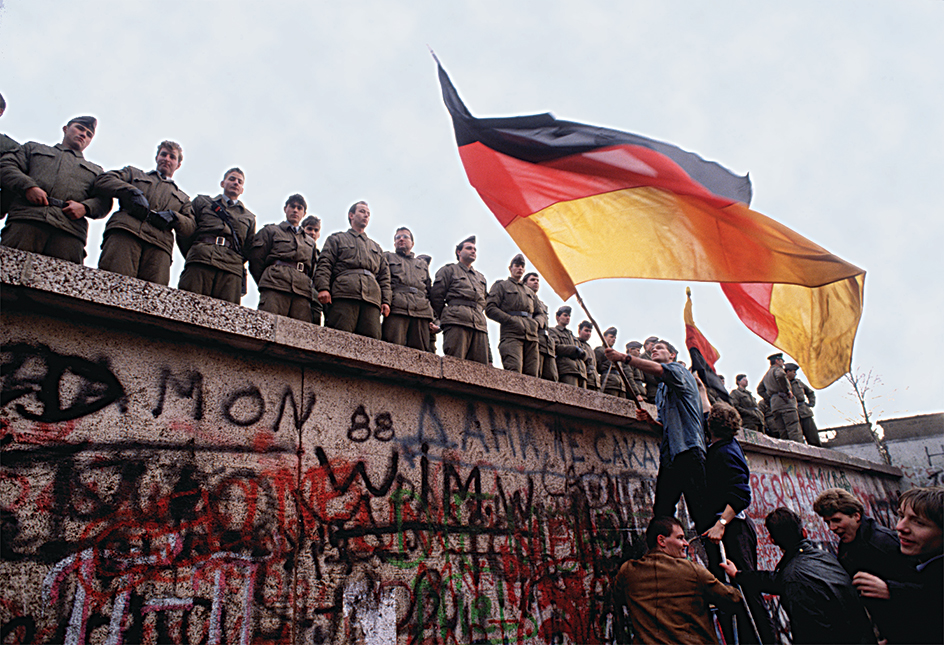

Scientific and technological achievements.

Research into the structure of the atom led to the discovery of nuclear energy as a source of power. Remotely controlled space probes explored other planets and sent back data that helped scientists understand the origins and structure of the solar system.
In addition, the life expectancy of human beings rose. Antibiotics and other drugs helped physicians treat many diseases that could not be treated effectively before. Agricultural output soared as scientists developed better plants and effective fertilizers and pesticides. As a result, millions of people lived healthier, longer lives.
In some cases, human achievements created new problems. Nuclear research led to the creation of powerful weapons. A growing knowledge of the genetic makeup of human beings fueled debates about the ethical uses of such knowledge. The rapid growth of industrial technology created so great a demand for fuel that the world occasionally experienced fuel shortages. Extensive use of petroleum generated much pollution. By the late 1900’s, there was mounting evidence that carbon dioxide emissions were contributing to a general warming of Earth’s climate.
Increases in life expectancy contributed to overpopulation in many developing countries, where birth rates remained high and death rates fell. As population increased, people turned forestlands into cities, factories, and fields. This expansion caused the extinction of many animal and plant species after 1900. Fishing methods became so effective in the 1900’s that some fish species became extinct, while others barely survived. See Technology (Challenges of technology).
A turbulent and interdependent world.
The world remains politically divided. No war has broken out directly between major world powers since World War II ended in 1945. But fighting has gone on in some part of the globe almost every day since then.
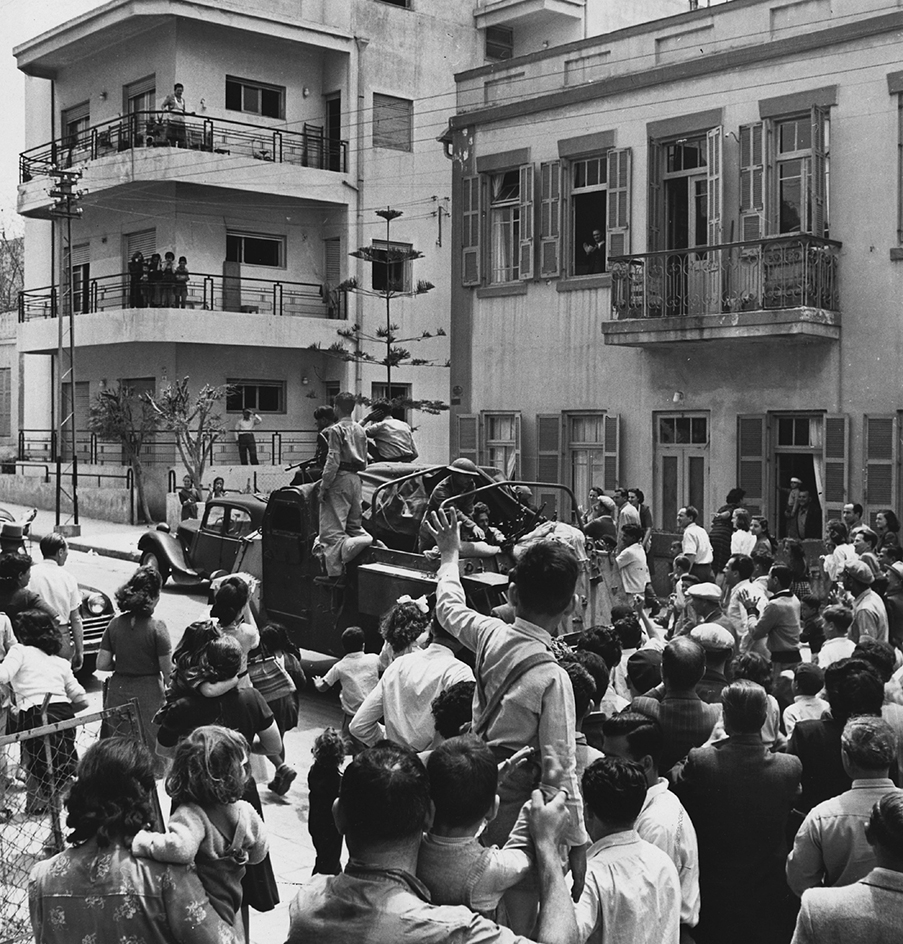
From the 1950’s to the 1970’s, Cold War tensions fueled many conflicts. The collapse of the Soviet Union and the end of the Cold War led to a power vacuum in much of eastern Europe and central Asia. Tensions in those areas contributed to political division and violent conflicts between ethnic or religious groups.
Regional conflicts occasionally have broken out after local rulers tried to extend their influence to neighboring areas. In 1991, for example, the United States, the United Kingdom, and other countries drove Iraq out of Kuwait after Iraq invaded and occupied Kuwait in 1990 (see Persian Gulf War of 1991). In 1999, the United States and several European countries attacked Serbia. The move came after Serbian leader Slobodan Milosevic ended self-rule in the province of Kosovo and deprived the province’s ethnic Albanian majority of many rights.
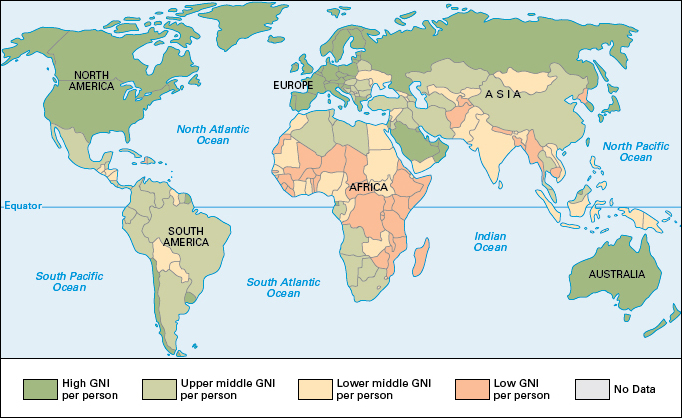
Countries have increasingly joined forces to deal with problems that are too big for any one government to handle. Such problems include pollution and the reduction of natural resources. Many countries belong to international economic or political organizations that work to coordinate policies on important issues, deal with large-scale health problems, improve working conditions, increase trade, or stabilize the global economy. Some developed countries also give financial and technical aid to developing nations.
The ability of people to travel more easily and rapidly than ever before between different parts of the world has helped the spread of diseases. For example, the virus known as HIV, which causes AIDS, began to spread from Africa to many parts of the world in the 1970’s. By the early 2000’s, AIDS had taken millions of lives. In 2003, the virus that causes severe acute respiratory syndrome (SARS) spread from China to other countries, causing a public health crisis. A similar virus caused Middle East respiratory syndrome (MERS), a disease that spread in and around the Arabian Peninsula beginning in 2012. Another dangerous respiratory disease, COVID-19, broke out in China in 2019 and became a pandemic (worldwide epidemic) in 2020.
The war on terrorism.
Modern technology has also aided the spread of terrorism. After the Persian Gulf War of 1991, some Muslims objected to the presence of U.S. troops in Saudi Arabia, the site of Islam’s holiest shrines. The Saudi-born millionaire and radical Osama bin Laden organized a terrorist group named al-Qa`ida. On Sept. 11, 2001, Qa`ida terrorists hijacked commercial jetliners and crashed them into the World Trade Center in New York City and the Pentagon Building near Washington, D.C. Another hijacked jet crashed in rural Pennsylvania. About 3,000 people of many nationalities died in the attacks. See September 11 terrorist attacks.
In response to the September 11 attacks, the United States led the United Kingdom and other nations in military action in southwest Asia. In Afghanistan, where bin Laden was based, U.S.-led forces destroyed many terrorist camps. They also overthrew the government of the Taliban—a radical Muslim group that supported bin Laden and al-Qa`ida. After the conflict, the UN aided the formation of a new national government in Afghanistan. However, it was clear that Afghanistan was only one of several countries that harbored terrorist groups and that the “war on terrorism,” also called the “war on terror,” would probably continue into the future. On May 2, 2011, nearly 10 years after the September 11 attacks, U.S. forces killed Osama bin Laden in Abbottabad, Pakistan. See Afghanistan War.
In 2003, U.S. President George W. Bush accused Iraqi leader Saddam Hussein of supporting international terrorist groups and possessing weapons of mass destruction—that is, biological, chemical, or nuclear weapons. That year, the United States led forces from the United Kingdom, Australia, and other countries and overthrew Iraq’s government. But in the months following the U.S.-led invasion, search teams found no weapons of mass destruction in Iraq. See Iraq War.
The growing ability of distant individuals, groups, and governments to interact directly has presented challenges and even dangers to the world’s citizens. However, these global links hold strong potential to increase prosperity and the quality of life worldwide. Many leaders believe that change for the better will require not only a victory over terrorism but also a more equal distribution of wealth and resources among the nations and peoples of the world.
